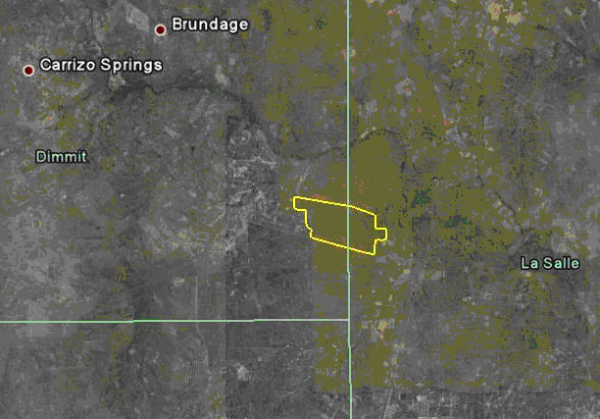Work Session
Wednesday, November 7, 2012
9:00 a.m.
Texas Parks and Wildlife Department
Commission Hearing Room4200 Smith School Road, Austin, TX 78744
Chairman T. Dan Friedkin, Commission Chair
Carter Smith, Executive Director
Approval of the Previous Minutes from the Committee Meeting held August 29, 2012
Land and Water Plan
1. Update on TPWD Progress in Implementing the TPWD Land and Water Resources Conservation and Recreation Plan – Carter Smith
- Internal Affairs Report
- Stocking Report for Fiscal Year 2012
- Agency Staff Member Recognized for Professional Contribution
- Texas Artificial Reef Program Planning Zones Off Corpus Christi
- Texas Outdoor Family – Fall Workshops
- FY12 Capital Construction Program
- TPWD and Brazos River Authority Collaborate to Minimize Impacts to Fisheries
- 58th Game Warden Cadet Class
- Private Lands on-the-ground Conservation Projects
Legislation
2. Legislative Preview and Update – Carter Smith
Natural Resources Regulations
3. Sand and Gravel Permit Program Rules – Request Permission to Publish Proposed Changes in the Texas Register – Tom Heger, Bob Sweeney
4. 2013-2014 Statewide Hunting Proclamation Preview Briefing – Shawn Gray
5. 2013-2014 Statewide Recreational and Commercial Fishing Proclamation Preview Briefing — Ken Kurzawski, Robin Riechers, Brandi Reeder
6. Deer Breeder Regulation Changes – Request Permission to Publish Proposed Changes in the Texas Register — Mitch Lockwood
7. Chronic Wasting Disease (CWD) Rules – Recommended Adoption of Proposed Changes — Mitch Lockwood (Action Item No. 7)
8. Revised Environmental MOU with Texas Department of Transportation (TxDOT) – Request Permission to Publish Proposed Rule in the Texas Register – Ted Hollingsworth
9. Coastal User Working Group Report – Jeremy Leitz
Communications and Outreach Regulations
10. Boater Education Deferral Rules – Recommended Adoption of Proposed Changes – Scott Boruff (Action Item No. 9)
11. Rules Regarding Official Corporate Partners and Licensing Department Brands – Recommended Adoption of Proposed Changes — Darcy Bontempo (Action Item No. 10)
Regulations—Rule Review
12. Regulations Rule Review – Ann Bright
- Begin Rule Review
- Chapter 57 – Fisheries
- Chapter 58 – Oysters & Shrimp
- Chapter 65 – Wildlife
- Publish Proposed Changes to the Following Chapters Based on the Rule Review
- Chapter 53 – Finance
- Chapter 59 – Parks
- Chapter 69 – Resource Protection
- Recommended Adoption of Proposed Changes and Completed Rule Review
(Action Item No. 2)
- Chapter 51 – Executive
- Chapter 52 – Stocking Policy (No Changes)
- Chapter 55 – Law Enforcement (No Changes)
- Chapter 60 – Maintenance Review (No Changes)
- Chapter 61 – Design and Construction
Land Conservation—Easements
13. Expansion of Existing Easement – El Paso County – Modification of FAA Tramway at Franklin Mountains State Park – Request Permission to begin the Public Notice and Input Process – Corky Kuhlmann
14. Request for Pipeline Easement – Parker County – Pipeline Crossing Lake Mineral Wells Trailway – Request Permission to begin the Public Notice and Input Process – Ted Hollingsworth
15. Request for Pipeline Easement – Brazoria County – Two Hydrocarbon Pipelines at the Justin Hurst Wildlife Management Area (WMA) — Ted Hollingsworth (Action Item No. 4)
Land Conservation—Land Acquisition
16. Acceptance of Land Donation – Brazoria County – Approximately 480 Acres at the Christmas Bay Coastal Preserve – Request Permission to begin the Public Notice and Input Process – Ted Hollingsworth
17. Land Acquisition – Bexar County – 461 Acres at Government Canyon State Natural Area – Ted Hollingsworth (Action Item No. 5)
19. Land Acquisition – Hemphill County – Approximately 473 Acres as an Addition to the Gene Howe Wildlife Management Area (WMA) – Request Permission to begin the Public Notice and Input Process – Corky Kuhlmann
20. WITHDRAWN — Acceptance of Land Donation – El Paso County – 600 Acres as an Addition to the Franklin Mountains State Park – Request Permission to begin the Public Notice and Input Process – Corky Kuhlmann
Land Conservation—Land Transfer/Sale
21. Land Sale and Trade – Bastrop County – Sale and Trade of Small Parcels to Conform to Survey Lines at Bastrop State Park – Request Permission to begin the Public Notice and Input Process – Corky Kuhlmann
Land Conservation—Other Land Transactions
22. Request for Deed Modification – Harris and Montgomery Counties – Authorization of Pipeline Easement at Lake Houston Wilderness Park – Request Permission to begin the Public Notice and Input Process – Ted Hollingsworth
23. Update on Surface Use Negotiations – Dimmit and LaSalle Counties – Oil and Gas Development at the Chaparral Wildlife Management Area (WMA) – Ross Melinchuk (Executive Session)
Work Session Agenda Item No. 1
Presenter: Carter Smith
Work Session
Update on TPWD Progress in Implementing the
TPWD Land and Water Resources Conservation and Recreation Plan
November 7, 2012
I. Executive Summary: Executive Director Carter Smith will briefly update the Commission on the status of the agency’s efforts to implement the Land and Water Resources Conservation and Recreation Plan (the “Plan”).
II. Discussion: In 2001, the 77th Texas Legislature directed that the Texas Parks and Wildlife Department (TPWD) develop a Land and Water Resources Conservation and Recreation Plan (Tex. Park & Wild. Code §11.104). In 2002, the Texas Parks and Wildlife Commission (the Commission) adopted the first Plan. A revised Plan was adopted by the Commission in January 2005. In November 2009, the Commission approved a new Plan effective January 1, 2010. The 2010 Plan is available on the TPWD web site. Executive Director Carter Smith will update the Commission on TPWD’s recent progress in achieving the Plan’s goals, objectives and deliverables.
The Plan consists of the following four goals:
- Practice, Encourage and Enable Science-based Stewardship of Natural and Cultural Resources
- Increase Access To and Participation In the Outdoors
- Educate, Inform and Engage Texas Citizens in Support of Conservation and Recreation
- Employ Efficient, Sustainable and Sound Business Practices
Work Session Agenda Item No. 2
Presenter: Carter Smith
Work Session
Legislative Preview and Update
83rd Texas Legislature (2013)
November 7, 2012
I. Executive Summary: Staff will present a legislative preview and update for the 83rd Texas Legislative Session for the Fiscal Year 2013-2014 biennium.
II. Discussion: Staff will provide updates regarding the joint budget hearing with oversight offices. Staff will also discuss legislative issues and initiatives that may impact Texas Parks and Wildlife Department in the upcoming session.
Work Session Agenda Item No. 3
Presenter: Tom Heger
Work Session
Sand and Gravel Permit Rules and Fee
November 7, 2012
I. Executive Summary: This item seeks permission to publish proposed amendments to sand and gravel regulations in the Texas Register for public comment. The proposed rules would:
- Address recommendations made in an Internal Audit report on the sand and gravel program, including establishment of penalties and interest charges for late reports and royalty payments;
- Improve public notice requirements;
- Modify the study requirement in §69.108(c) to cover all activities within department jurisdiction;
- Increase the time limit for department processing of general permits;
- Require applicants to furnish a driver’s license number and date of birth in order to facilitate the required background check;
- Increase the fee for a general permit from $250 to $500 to better recoup actual department costs;
- Require that projects address passage of normal low flows in addition to expected high flows; and
- Make miscellaneous housekeeping-type changes to update references and comply with statutory requirements.
II. Discussion: Under Parks and Wildlife Code, Chapter 86, the Texas Parks and Wildlife Commission is required to manage, control, and protect marl and sand of commercial value and all gravel shell, and mudshell located within the tidewater limits of the state and within the freshwater areas of the state not embraced by a survey of private land. Chapter 86 also prohibits the disturbance or take of marl, sand, gravel, shell, or mudshell under the management and protection of the Commission without a permit, with limited exceptions. The statute additionally allows the granting of a permit upon a finding that a proposed activity will not significantly increase nonpoint source pollution; significantly accelerate erosion; damage or injuriously affect hydrology of a river; any island, reef, bar, channel, river, creek, or bayou used for navigation or any oysters, ouster beds, fish, or wildlife in or near the activity.
The current rules governing sand and gravel removal have not been significantly altered since 1997. Over the last 15 years, staff has identified certain areas where the rules in their current state could be improved. Moreover, a recent internal audit of the sand and gravel program found that the rules did not create a sufficient incentive for timely royalty payments and timely submission of reports. Additionally, the fee charged for general permits is insufficient to recover the cost of administering and enforcing the permit program. Thus, staff concludes that rule changes are appropriate and will aid in administration of the program.
Attachments – 1
Work Session Agenda Item No. 3
Exhibit A
SAND AND GRAVEL PERMIT RULES
PROPOSAL PREAMBLE
1. Introduction.
The Texas Parks and Wildlife Department proposes amendments to §§69.102, 69.105, 69.107, 69.108, and 69.116-121, concerning Issuance of Marl, Sand, and Gravel Permits.
The proposed amendment to §69.102, concerning Definitions, would alter paragraph (8) to refer to the Texas Commission on Environmental Quality rather than its precursor agency, the Texas Natural Resource Conservation Commission.
The proposed amendment to §69.105, concerning Application Procedures: Individual Permit, would alter the notice requirements of the section. Under Parks and Wildlife Code, §86.007(d), the department is required to provide public notice of a proposed activity (i.e., an application to disturb or remove marl, sand, or gravel from public water). Neither the statute nor the current rule specifies the minimum content of the required notice. The department has determined that it is useful to prospective applicants, the regulated community, and the community to stipulate the contents of the public notice. Therefore, the proposed amendment creates new paragraph (1), which would require the public notice to describe the proposed activity, the location of the proposed activity, establish a time and place for a public hearing, prescribe a method for submitting public comment, and provide a deadline for the submission of public comment.
The proposed amendment to §65.105 also would remove the requirement that interested parties submit a written request to obtain a copy of a notice required under subsection (a). The department has determined that any method of request (phone, e-mail, etc.) is sufficient.
The proposed amendment to §65.105 also removes the requirement that the department publish notice of a hearing and opportunity for public comment in the Texas Register. The Texas Register has a highly specialized readership and is not always an effective means for the general public to become aware of public hearings regarding sand and gravel permit applications. The proposed amendment also stipulates that the public comment period shall begin on the lattermost date of the newspaper notices currently required by the section.
The proposed amendment to §69.107, concerning Contested Case Hearings, would alter subsection (a) to replace the word “justifiable” with the word “justiciable.” The word “justifiable” implies a broad range of possible involved interests, but because this section is applicable specifically to hearings before the State Office of Administrative Hearings, “justiciable” is the more accurate term, because it would acknowledge that the applicability of the section is restricted to those issues capable of being decided by legal principles or court proceedings.
The proposed amendment to §69.108, concerning Criteria, would make several changes to subsection (c). The current rule makes reference to permits issued to “sites.” This term is imprecise, because permits authorize specific activities at a specific location at a specific time. As currently worded, the provision could potentially be misconstrued to mean that once a permit has been issued for a specific place, there is no further obligation under any circumstances for the permittee to comply with the requirements of the section, which isn’t the case. In order to provide for greater clarity as to exactly what triggers the requirements of the section, the proposed amendment would replace the word “site” with the word “project.”
The proposed amendment to §68.108(c) also would replace the phrase “state-owned streambed” with the phrase “navigable stream.” The jurisdiction of the department under Parks and Wildlife Code, Chapter 86 encompasses the beds of navigable streams, a term that is broader than “state-owned streambed.”
The proposed amendment to §68.108(c) also would replace the word “mined” with the word “affected,” because mining is a limiting term in the context of various activities that might affect marl, sand, and gravel in public waters and for which a permit is required.
The proposed amendment to §69.116, concerning Conditions, would correct an erroneous internal reference in paragraph (3).
The proposed amendment to §69.117, concerning Notification, would increase the time limit for the department to process applications for a General Permit, from 30 days to 45 days. The current rule allows 30 days for application processing, but because the public comment period itself is 30 days, staff has very little time to analyze and consider public comment in instances when significant public comment arrives late in the comment period. Lengthening the processing time would alleviate that concern. The proposed amendment also would stipulate that an applicant provide a date of birth, Social Security number, and Texas drivers license number as part of the application process. The information is necessary to facilitate background checks to ensure that the applicant does not owe the department money or is otherwise not eligible to receive a permit. Both state and federal laws regarding child support collection require the department to obtain social security numbers for each applicant for a license or permit. Tex. Fam. Code §§231.302, 42 U.S.C. §666. The proposed amendment also makes a nonsubstantive grammatical change in subsection (b) and removes a reference in subsection (d) to a term no longer used in the Texas Administrative Code.
The proposed amendment to §69.118, concerning Best Management Practices, would alter subsection (g) to require all projects to allow the passage of water during normal low-flow conditions. Under the current rule, a permittee “shall not restrict or impede the passage of normal or expected high flows or cause the relocation or diversion of water.” The intent of the current rule is to prevent the diversion of flows, not to authorize the restriction of flows in normal or low-flow conditions. The proposed amendment would clarify that restricting or impeding flows is prohibited at all times.
The proposed amendment to §69.119, concerning Fees, would clarify that the fee described in the section applies to general permits only, and increase the processing fee for a general permit from $250 to $500. At the current fee amount, the department is unable to recover the expenses of administering the program. Such costs are related to initial review; background checks, site inspections, and project-specific research and analysis; analysis of and response to public comment; follow-up and confirmation activities; and miscellaneous administrative functions.
The proposed amendment to §69.120, concerning Exemptions, would add the construction of new utility lines to the list of activities exempted from permit requirements by rule. Parks and Wildlife Code, §86.191(a) requires the commission to by rule exempt the construction of new utility lines carried out by public utilities from the applicability of the subchapter. The proposed amendment would comport the agency’s regulations with the statutory requirements of Chapter 86.
The proposed amendment to §69.121, concerning Prices, would create a mechanism for the department to impose penalties and interest on permittees who are delinquent in the payment of royalties or the submission of reports or documents or for the submission of incorrect reports, affidavits, or documents. The proposed amendment would stipulate that as of the effective date of the section, any royalty not paid when due or any required affidavit, report, or document not submitted when due would be delinquent and subject to penalties. For delinquent royalty payments, the penalties would consist of five percent of the delinquent amount or $50, whichever is greater, for royalties delinquent less than 30 days; or 10 percent of the delinquent amount or $50, whichever is greater, for royalties delinquent more than 30 days. For delinquent or incorrect reports and documents, the penalty would consist of $25 per document, affidavit, or report. The proposed amendment also would require the payment of interest on delinquent royalties at the rate of 12% per year (simple interest), beginning 30 days after the due date of the royalty payment. In 2011, the department conducted an internal audit of the sand and gravel program’s business model and determined that permittees were substantially noncompliant with regulatory deadlines for the submission of royalty payments and reports. This finding was also identified in a 2009 audit. When royalty payments are not timely remitted, the department is denied the full use and benefit of funds that are due. When required affidavits, reports and other documents are incorrect or not timely filed, department staff must expend additional effort to rectify the deficiency. The department therefore believes it is appropriate to promulgate rules to create a monetary penalty that accrues in value the longer the deficiency exists. The department based the values contained in the proposed amendment on the provisions used by the General Land Office to calculate penalty and interest payments with respect to oil and gas royalties paid to the state under the provisions of 31 TAC §9.51, concerning Royalty and Reporting Obligations to the State.
2. Fiscal Note.
Tom Heger, Sand and Gravel Permit Program Administrator, has determined that for each of the first five years that the rules as proposed are in effect, there will be fiscal implications to state government as a result of enforcing or administering the rule. Those implications will be positive for the state, since the proposed rule would increase the fee for a general permit from $250 to $500. This value was derived by estimating the current value of staff time committed to processing an application and subtracting the current permit fee value. The department’s calculations indicate that on average, the department spends approximately $515 in the process of issuing a permit (to include initial review, background checks, site inspections, project-specific research and analysis, analysis of and response to public comment; follow-up and confirmation activities, and miscellaneous administrative functions).
There will be no fiscal implications for other units of state or local government.
3. Public Benefit/Cost Note.
Mr. Heger also has determined that for each of the first five years the rules as proposed are in effect:
(A) The public benefit anticipated as a result of enforcing or administering the rules as proposed will be rules that recoup the department’s cost to administer the program and protect the public fresh water resources of the state.
(B) There will be an adverse economic effect on persons required to comply with the rule as proposed; namely, the $250 increase in the fee for a general permit. Also, persons who are delinquent in submission of royalty payments or reports will owe additional charges.
(C) Under the provisions of Government Code, Chapter 2006, a state agency must prepare an economic impact statement and a regulatory flexibility analysis for a rule that may have an adverse economic effect on small businesses and micro-businesses. As required by Government Code, §2006.002(g), the Office of the Attorney General has prepared guidelines to assist state agencies in determining a proposed rule’s potential adverse economic impact on small businesses. Those guidelines state that an agency need only consider a proposed rule’s “direct adverse economic impacts” to small businesses and micro-businesses to determine if any further analysis is required. For that purpose, the department considers “direct economic impact” to mean a requirement that would directly impose recordkeeping or reporting requirements; impose taxes or fees; result in lost sales or profits; adversely affect market competition; or require the purchase or modification of equipment or services. The proposed amendments affect individuals who may wish to obtain a general permit to remove or disturb marl, sand, or gravel from public water. Since the demand for permits is not seasonal, periodic, or otherwise predictable, the department bases this analysis on the historical average of the number of permits over each of the last three years, which is 20. These entities would incur a minimum adverse economic impact of $250, which reflects the $250 fee increase for a permit. Further adverse economic impacts could occur for permittees required to pay penalties and/or interest as a result of delinquent royalty payments or reports, affidavits, or documents, or who submit incorrect reports, affidavits, or documents. The magnitude of such adverse economic impacts is dependent on the number of violations and the length of time that elapses between notification and resolution; therefore, it is impossible to calculate a meaningful estimate of potential adverse economic impacts related to the payment of penalties and/or interest. The department notes, however, that permittees who comply with the rules as proposed and timely submit documentation/pay royalties will experience no adverse economic impact related to penalties and interest.
The department considered several alternatives to achieve the goals of the proposed amendment while reducing potential adverse impacts on small and micro-businesses and persons required to comply. The component of the proposed rules that constitutes an adverse economic impact to small and microbusinesses is the proposed fee increase. One alternative the department considered was proposing no fee increase. This alternative was rejected because the goal of the proposed fee increase is to recover the administrative cost of operating the sand and gravel permit program. The department concluded that the need to recover the costs of administering the program outweighs the adverse economic impacts to small and micro-businesses and persons required to comply.
The department also considered creating a metered payment program, in which applicants would be billed for the actual cost to the department of processing, evaluating, and issuing the permit issued specifically to the applicant. This alternative was rejected because the department believes a general approach that establishes one fee based on the average cost of permit issuance is more efficient and less costly than an approach that would require more intensive recordkeeping, accounting, billings, and monitoring processes.
The department also considered increasing the fee by a lesser amount. This alternative also was rejected because the goal of the proposed fee increase is to recover the administrative cost of operating the sand and gravel permit program and the need to recover the costs of administering the program outweighs the adverse economic impacts to small and micro-businesses and persons required to comply.
(D) The department has not drafted a local employment impact statement under the Administrative Procedures Act, §2001.022, as the agency has determined that the rule as proposed will not impact local economies.
(E) The department has determined that there will not be a taking of private real property, as defined by Government Code, Chapter 2007, as a result of the proposed rule.
4. Request for Public Comment.
Comments on the proposed rules may be submitted to Tom Heger, Texas Parks and Wildlife Department 4200 Smith School Road, Austin, Texas, 78744; (512) 389-4583 (e-mail: tom.heger@tpwd.state.tx.us).
5. Statutory Authority.
The amendments are proposed under authority of Parks and Wildlife Code, Chapter 86, which authorizes the commission to adopt rules to govern consideration of applications; setting and collection of application fees; assessment of transcript costs in contested cases; permit conditions; issuance of permits by rule; pricing of and terms for payment for substrate materials; and any other matter necessary for the administration of the chapter. Chapter 86 also authorizes the commission to by rule to establish conditions under which specified activities are authorized without the requirement of individual permits under the chapter, requires a person proposing to rely on the authorization provided for by §86.007 to notify the department and, as appropriate, to report to the department during and after the activity, authorizes the commission to require a nonrefundable processing fee to be submitted with the notification, and requires the commission to by rule exempt entities from the requirements of the chapter regarding permits and fees required for disturbing or taking marl, sand, gravel, shell, and mudshell for noncommercial purposes when such disturbances or takings occur for maintenance projects or construction of new utility lines carried out by public utilities.
The proposed amendments affect Parks and Wildlife Code, Chapter 86.
6. Text.
§69.102 Definitions. The following words and terms, when used in this chapter, shall have the following meanings unless the context clearly indicates otherwise.
(1) Administratively complete — An application is administratively complete when all information required for staff evaluation has been submitted with all necessary maps, photographs, channel depths and sponsor/owner application forms.
(2) Applicant — Any person applying for a permit.
(3) Director — The Executive Director of the Parks and Wildlife Department.
(4) Evidence — A presentation of facts orally or in writing by affidavit, deposition, or in person, and may include maps, pictures, diagrams, models, and learned treatises.
(5) General permit — An authorization to disturb or remove sedimentary materials from the public waters of the state under conditions that qualify such activity as insignificant.
(6) Individual permit — An authorization to disturb or remove sedimentary materials from the public waters of the state for any proposed activity that does not qualify for a general permit.
(7) Person — Any person, firm, partnership, association, corporation, or entity.
(8) River segment — Reach of river and tributaries as designated by the Texas Commission for Environmental Quality (TCEQ) [TNRCC] based on flow and water quality attributes in the Surface Water Quality Standards.
(9) Sedimentary materials — Marl, sand, mudshell, gravel, or any combination of them.
(10) Waters — All of the salt and fresh water of the area of this state under the jurisdiction and trusteeship or ownership of the government of the State of Texas, all the volume of such water area, and all lands underlying such water area, and all lands subject to the jurisdiction of the commission underlying the beds of navigable streams, whether containing water or not, as defined in Texas Civil Statutes, Article 5302.
§69.105. Application Procedures: Individual Permit.
(a) The application for an individual permit shall set forth the proposed location, quantities, kinds of materials to be removed, equipment to be used, period of time, names of alongshore property owners on both sides of the waterway for one-half mile both upstream and downstream of the proposed operation, and other information as may be required.
(b) Within 30 days of receipt of an administratively complete application, the department shall:
(1) prepare a notice of public hearing and opportunity for public comment that describes the proposed activity, specifies the location of the proposed activity, provides that written comments may be sent to the executive director at 4200 Smith School Road, Austin, Texas, 78744 or by email to an address designated in the notice, sets a time and place for a public comment hearing, and sets a deadline for receipt of written comments[set a time and place for a public comment hearing to receive public comment on the application];
(2) mail a copy of the notice to all alongshore property owners as listed in the application and to any person who has made a [written] request for forwarding of this information, and shall notify the applicant;
(3)[(2)] send a copy of the notice to the daily newspaper of greatest circulation in the county or counties to be affected by the issuance of the permit, with a request that the notice be published for three consecutive days; and
(4)[(4)] send a copy of the notice to the daily or weekly local newspaper, where available, in the community nearest the proposed location, with a request that the notice be published for one day.
(c) The public notice shall set forth in full any trade or corporate name used by the applicant. The applicant shall be responsible for prompt and full payment for all newspaper notice required.
(d) A completed publisher’s affidavit for all required newspaper notice shall be required prior to commencement of a contested case hearing.
(e) The department shall set a 30-day public comment period to begin on the date of publication of the latest of the required newspaper notices[in the Texas Register or the newspaper(s), whichever is later]. All relevant public comment shall be presented to the executive director or the commission at the time the permit application is presented for decision.
§69.107. Contested Case Hearings.
(a) A written request for a contested case hearing from an applicant or a person with a justiciable [justifiable] interest must be received prior to the close of the public comment period and shall be referred to the Office of Administrative Hearings (OAH) within 45 days after the close of the public comment period. Proposed activities shall not commence or continue after the date on which an application is referred to the OAH until a valid permit is issued.
(b) Contested cases shall be conducted pursuant to the Procedural Rules of the commission and any applicable rules of the State Office of Administrative Hearings.
(c) The applicant shall be responsible for all hearing costs to the State Office of Administrative Hearings, transcript costs incurred by the department, and court reporting costs incurred by the department and no permit may be issued pursuant to this section before full payment of all proper costs have been made to the department by the applicant.
§69.108. Criteria.
(a) The director may consider the following criteria in determining whether to grant or deny a permit:
(1) the past performance of the applicant with respect to its obedience and strict observance of the terms of past permits;
(2) whether the applicant shows evidence of financial responsibility;
(3) the ability of the applicant to operate, including its facilities for operation;
(4) the existence of sedimentary materials in the area applied for;
(5) whether the granting of the permit will have a material adverse effect on recreational activity in the general area affected by the permit;
(6) whether the granting of the permit will have a material adverse effect on commercial fishing or the general seafood industry in the general area affected by the permit;
(7) the effect, if any, on navigation in the general area affected by the permit.
(b) The director shall consider the following criteria in determining whether to grant or deny a permit:
(1) whether operation under the proposed permit will damage or injuriously affect oysters, oyster beds, or fish-inhabiting waters thereof or adjacent thereto;
(2) whether the operation will damage or injuriously affect any island, reef, bar, channel, river, creek, or bayou used for frequent or occasional navigation, or change or otherwise injuriously affect any current that will affect navigation;
(3) the requirements of industry for such sedimentary materials and the relative value to the State of Texas for commercial use.
(c) No permit for a project[site ]previously unpermitted for the past five years may be issued for the disturbance or removal of 1,000 cubic yards or more of sedimentary materials from any navigable stream[state-owned streambed] unless a commission approved study evaluating sediment budget, erosion rates of the river segment or segments to be affected[mined], and the effect on coastal and receiving waters has been completed within the immediately preceding five year period.
§69.116. Conditions. A general permit may be authorized for an activity listed in §69.115(b) of this title (relating to General Permit), provided that the proposed activity:
(1) will have no significant adverse effects on a natural resource of the state as set forth in Parks and Wildlife Code, §86.004;
(2) is minimal in scope and duration; and
(3) will be conducted in compliance with the best management practices set forth in §69.118[§69.101] of this title (relating to Best Management Practices).
§69.117. Notification and Reporting for General Permits.
(a) Notification to the department.
(1) At least 45[30] days prior to the commencement of the proposed activity, the applicant shall notify the department at its headquarters address of 4200 Smith School Road, Austin, Texas 78744, of the proposed activity by certified mail, return receipt requested. The application[ letter]shall, at a minimum, include:
(A) the name, address, telephone number, date of birth, social security number, and driver’s license number of the applicant;
(B) a description of the proposed activity or a plan of the proposed project;
(C) the size of the pipeline or cable, the width of the proposed trench, and the width of the right-of-way to be disturbed;
(D) a vicinity map showing the location of the proposed activity;
(E) the estimated amount of sedimentary material to be disturbed or removed and a description of its intended final disposal area; and
(F) the date that the proposed activity will begin;
(G) a statement disclosing whether or not any species listed as state or federal threatened or endangered species might be affected by, or found in the vicinity of, the proposed project; and
(H) maps, drawings and/or photographs depicting property of adjacent landowners and other resources including trees, wetlands, aquatic habitats such as channels or shallows.
(2) An activity is authorized if there is no response from the department within 45[30] days from the date of notification. A written confirmation of authorization may be obtained from the department, if requested.
(b) Public notice. Simultaneous with the notification to the department required by subsection (a) of this section, the applicant must give public notice by publication for one day in the daily newspaper of greatest circulation in the county or counties to be affected by the issuance of the permit, and a copy of the notice shall be posted at the county courthouse(s) in the affected county or counties. Such notice shall describe the proposed activity, specify the location of the proposed activity, specify the date that operations are to begin, and contain language informing the public that written comments may be sent to the executive director at 4200 Smith School Road, Austin, Texas 78744 or by calling 1-800-792-1112.
(c) Waiver of notice requirement. The notification requirements of subsection (b) of this section shall not apply in the case of an emergency that requires immediate action to prevent a threat to human health and safety or the environment. In such instances the applicant shall promptly notify the department that an emergency exists, and within ten days of completing an emergency activity, submit a written report to the department. Such report shall include:
(1) the name, address, and telephone number of the applicant;
(2) a description of the emergency activity;
(3) a small-scale map showing the location of the emergency activity;
(4) the estimated amount of sedimentary material disturbed or removed as a result of the emergency activity; and
(5) the date(s) the emergency activity took place.
(d) Additional requirements. The department may, at its discretion, require a permittee to furnish reports during and after any activity authorized under the provisions of this subchapter[ undesignated head].
§69.118. Best Management Practices.
(a) In issuing a general permit, the department relies in part on the information provided by the permittee with the notification. If such information proves to be false, incomplete, or inaccurate, a permit may be modified, suspended, or revoked, in whole or in part following the administrative proceedings required by law.
(b) Structures and activities authorized under a general permit shall be in compliance with all applicable terms and conditions of §69.115 of this title (relating to General Permits), §69.117 of this title (relating to Notification and Reporting for General Permits), and this section. Failure to abide by such conditions invalidates the authorization and may constitute operation without a permit.
(c) Permittee shall not prevent the full and free public use of navigable waters at or adjacent to the project.
(d) There shall be no interference with navigation.
(e) Permittee shall make every reasonable effort to conduct the activities authorized hereunder in a manner which minimizes any adverse impact of the work on water quality, fish and wildlife and their habitats, and the natural environment.
(f) Permittee shall allow authorized department representatives access to the project site as needed for periodic inspections to ensure that the activity being performed under this authorization is consistent with the terms and conditions herein.
(g) Stream or river realignment is not authorized under the general permit. Activities shall not restrict or impede the passage of normal low flows or expected high flows or cause the relocation or diversion of water.
(h) The project shall be designed to be stable against the forces of flowing water, wave action, and the wake of passing vessels.
(i) Appropriate erosion and siltation controls shall be used and maintained in effective operating condition during construction and all exposed soil and other fills shall be stabilized at the earliest practicable date.
(j) Activities conducted in wetlands shall be avoided if practicable. If not practicable, wetland activities shall be minimized through the use of other alternatives. Heavy equipment working in wetlands must be placed on mats, or other equivalent measures must be taken to minimize soil disturbance.
(k) No activities may occur within 1,000 feet of a public water supply intake, except for construction or repair of public water supply intake structures or adjacent bank stabilization.
(l) No authorization is granted under the general permit for an activity that is likely to result in the take of or jeopardize the continued existence of a threatened or endangered state or federal species or a species proposed for such designation, or for an activity that is likely to destroy or adversely modify the designated critical habitat of such species.
(m) The project shall not significantly disrupt the movement of species or aquatic life indigenous to the water body or those species that normally migrate through the project area. Activities in spawning areas during spawning seasons or in breeding areas for migratory waterfowl must be avoided to the maximum extent practicable.
(n) Trees, particularly mast-producing trees such as oaks and hickories, shall be avoided wherever practicable.
§69.119. Fees. The department shall charge a nonrefundable processing fee of $500 [$250] for a general permit[permits authorized under this undesignated head, payable at the time of the notification required by §69.117 of this title (relating to Notification and Reporting for General Permits)]. If the department determines that a general permit is not authorized for an activity, the processing fee shall be applied to the application fee for an individual permit.
§69.120. Exemptions. The commission finds that the state will not be deprived of significant revenue and there will be no significant adverse effects on navigation, the coastal sediment budget, riverine hydrology, erosion, or fish and wildlife resources or their habitat, and the following activities are therefore exempt from any permit requirement of the department or payment to the department for sedimentary material removed from the public waters of this state:
(1) projects to restore or maintain the storage capacity of existing public water supplies;
(2) maintenance projects or construction of new utility lines carried out by public utilities for noncommercial purposes; and
(3) public road projects of the Texas Department of Transportation.
§69.121. Prices.
(a) The commission, with the approval of the governor, establishes a minimum royalty of $.20 ton for sedimentary materials. The permittee shall pay the minimum royalty or a percent royalty of 6.25% on the average selling price per ton sold calculated on a monthly basis, whichever is higher. The percent royalty shall increase to 8.0% on September 1, 1996.
(1) Where the permittee uses a floating dredge and barge or does not have access to a scale, measurement of materials sold may be made in cubic yards and converted into tons according to industry standard prior to payment.
(2) Payment for materials dredged solely for personal use may be based on the minimum royalty.
(3) Penalties and interest on delinquencies.
(A) Penalties. Any royalty not paid when due, or any required affidavit, report, or document not submitted when due, is delinquent and penalties as provided in this paragraph shall be assessed. For royalties and reports due after the effective date of this section, the department shall add:
(i) a penalty of 5.0% of the delinquent amount or $50, whichever is greater, to any royalty which is delinquent 30 days or less;
(ii) a penalty of 10% of the delinquent amount or $50, whichever is greater to any royalty which is more than 30 days delinquent;
(iii) a penalty of $25 per document for each report, affidavit, or document that is delinquent or incorrect. An additional penalty of $25 per affidavit, report, or document that is delinquent or incorrect shall be assessed for each 30-day period that each affidavit, report, or document remains delinquent or is not corrected.
(B) Interest. Any royalty not paid is delinquent and shall accrue interest as provided in this subsection.
(i) interest shall accrue on all delinquent royalties at the rate of 12% per year (simple interest).
(ii) interest shall begin to accrue 30 days after the date due.
(b) The commission, with approval of the governor, establishes a price of $1.25 per cubic yard on all grades of shell removed from state-owned submerged tidelands. The price of shell will hereafter be adjusted semiannually, starting October 1, 1981, to reflect any increase or decrease (percent of change) in the Consumer Price Index of retail sales as prepared by the Bureau of Labor Statistics, U.S. Department of Labor (using the National Consumer Price Index, all urban consumers, 1967 equals 100) except that any adjustment for the six-month period starting October 1, 1981, will be based upon the Consumer Price Index statistics compiled for the six months ending June 30, 1981, and each succeeding six-month period will be adjusted in the same manner in order to provide permittees advanced notice of price adjustments, and except that the price of shell per cubic yard will be rounded off to the nearest whole cent and will not be adjusted in any six-month period to less than the base price of $1.25 per cubic yard as established in this section.
(c) In addition, 5.0% of all shell dredged from state-owned submerged tidelands will be delivered to points designated by the department in Texas bays and spread at permittee’s expense for reef enhancement. Except that when permittee is required to deliver and spread shell at a point greater than 50 statute miles (computed using the nearest water route through public navigational channels) from the dredge site, the director is authorized to adjust the amount of shell permittee is required to deliver and spread to a quantity less than 5.0% in order to offset permittee’s increased delivery cost for the distance over 50 miles. Permittee will not be required to pay for the shell used for reef enhancement.
(d) The department’s actual cost of monitoring the dredging operations from state-owned submerged tidelands, not to exceed $50,000 per year, will be assessed against each permittee in proportion to the quantity (percentage of the total) shell removed by each permittee; provided however the maximum monitoring cost of $50,000 will be adjusted each fiscal year using the Consumer Price Index (CPI-U) for the preceding 12-month period except that in no event will the maximum monitoring cost be adjusted below $50,000. The director is authorized to determine the methods and terms for payment of the monitoring cost.
This agency hereby certifies that the proposal has been reviewed by legal counsel and found to be within the agency’s authority to adopt.
Issued in Austin, Texas, on
Work Session Agenda Item No. 4
Presenter: Shawn Gray
Work Session
2013-2014 Statewide Hunting Proclamation
Preview Briefing
November 7, 2012
I. Executive Summary: This item apprises the Commission of potential changes to hunting regulations for the 2013-14 season.
II. Discussion: Responsibility for establishing seasons, bag limits, and means and methods for taking game animals and game birds is delegated to the Texas Parks and Wildlife Commission under Parks and Wildlife Code, Chapter 61 (Uniform Wildlife Regulatory Act). The potential changes are based upon statutory requirements and Commission policy, including scientific investigation and required findings of fact, where applicable. The potential changes are intended to increase recreational opportunity, decrease regulatory complexity where possible, promote enforcement, and provide for the sound biological management of the wildlife resources of the state.
Attachments – 1
Work Session Agenda Item No. 4
Exhibit A
Potential Changes to Hunting Regulations 2013-2014
Mule Deer
- Extension of mule deer season on Managed Lands Deer Permit properties.
Pronghorn
- Changes to seasons for pronghorn. Allow harvest without permit in three herd units under current season length and bag limits.
Work Session Agenda Item No. 5
Presenters: Ken Kurzawski
Robin Riechers
Brandi Reeder
Work Session
2013-2014 Statewide Recreational and Commercial Fishing Proclamation
Preview Briefing
November 7, 2012
I. Executive Summary: This item apprises the Commission of potential changes to recreational and commercial fishing regulations for the 2013-14 season.
II. Discussion: Responsibility for establishing seasons, bag limits, and means and methods for taking freshwater and saltwater fisheries resources is delegated to the Texas Parks and Wildlife Commission under Parks and Wildlife Code, Chapters 61 (Uniform Wildlife Regulatory Act), 66 (Fish), 67 (Nongame Species), 76 (Oysters), 77 (Shrimp), and 78 (Mussels, Clams, and Crabs). The potential changes are based upon statutory requirements and Commission policy, including scientific investigation and required findings of fact, where applicable. The potential changes are intended to increase recreational opportunity, decrease regulatory complexity where possible, promote enforcement, and provide for the sound biological management of the fisheries resources of the state.
Attachments – 1
Work Session Agenda Item No. 5
Exhibit A
Potential Changes to Fisheries Regulations 2013-2014
Inland Fisheries
- Modify existing regulation exemptions for largemouth bass on two reservoirs.
- Add definition for handfishing and clarify definition for enforceability.
Coastal Fisheries
- Clarification of definition regarding possession of fish.
Clarify that possession limits for aquatic resources apply until the resources reach the possessor’s permanent residence - Clarification of definition of fish harassment.
It is currently unlawful to use any vessel to harass fish. Staff proposes to clarify that it is unlawful to use an vessel to harry, herd, or drive fish including but not limited to operating any vessel in a repeated circular course, for the purpose of or resulting in the artificial concentration of fish for the purpose of taking or attempting to take fish. - Remove prohibitions concerning possession of red drum and bonus red drum tags.
Current rule prohibits the simultaneous possession of both a red drum tag and a bonus red drum tag. The rule is no longer necessary.
Law Enforcement
- Enforcement of federal regulations in state waters
Work Session Agenda Item No. 6
Presenter: Mitch Lockwood
Work Session
Deer Breeder Regulation Changes
November 7, 2012
I. Executive Summary: This item seeks permission to publish proposed amendments to the rules governing deer breeders in the Texas Register for public comment. The amended rules would mandate the submission of all required deer breeder reports and notifications via the department’s online reporting system (except for transfer permit activations, which may be reported online or by phone).
II. Discussion: Under Parks and Wildlife Code, Chapter 43, Subchapter L, the Commission is authorized to regulate the possession of deer held in captivity under a deer breeder’s permit.
The department’s online reporting system for permitted deer breeders is designed to (1) significantly reduce reporting errors, (2) provide for more efficient means of herd inventory reconciliation, and (3) make data more immediately available to department regulatory and enforcement personnel. In May of 2010, the Commission authorized a reduced renewal fee for permittees who reported online, which has been effective at encouraging many deer breeders to report required data (e.g., births, deaths, transfers) via the online reporting system; however, the reports that are still being submitted as hard copy are problematic. The data contained in hard-copy reports must be manually entered by staff, a task that diverts staff from performing other duties. Additionally, hard-copy reports frequently contain erroneous information and/or omissions, which require substantial amounts of staff time to rectify. Because online reporting cannot be successfully completed until all required information has been entered and reconciled by the system against existing historical user data, staff time spent on manual data entry/data reconciliation would virtually be eliminated if all reporting were required to be done online.
Attachments – 2
Work Session Agenda Item No. 6
Exhibit A
DEER BREEDER PROCLAMATION
PROPOSAL PREAMBLE
1. Introduction.
The Texas Parks and Wildlife Department (the department) proposes amendments to §§65.602, 65.603, 65.605, 65.608, and 65.610, concerning Deer Breeder Permits. The proposed amendments, collectively, would require all permit applications, permit renewals, notifications, and reports be submitted to the department via the department’s Internet-based deer breeder application.
Current rules allow for permit applications and renewals, reports, notifications, and similar required interactions with the department to be conducted either electronically or manually. In response to an increasing number of deer breeders and an increasing number of reporting errors, the department in 2005 created an Internet-based application for reporting and recordkeeping. Deer breeder permit holders are not currently required to use the Internet-based application, but they were offered an incentive do so in 2010 when the department implemented Parks and Wildlife Code, §43.369, as added by Senate Bill 1586 (2009) which required the department and the Texas Animal Health Commission (TAHC) to develop a process for a shared database to include reporting data provided by deer breeders. Section 43.369 also requires the Texas Parks and Wildlife Commission (the Commission) to provide incentives to deer breeders whose cooperation resulted in reduced costs and increased efficiencies. The Commission promulgated rules that provide for a fee reduction of 50% for deer breeder permittees who submitted at least 85% of the required reports and notifications via the Internet. Specifically, the current deer breeder and deer breeder annual renewal fee is $400, but for deer breeder permittees who submit at least 85% of the required reports and notifications via the Internet, the fee is $200. Increased utilization of the Internet-based application has resulted in increased efficiency in program administration; however, the department continues to receive numerous hard-copy reports that are laden with errors, requiring thousands of man hours to reconcile. Reconciliation of hard-copy reports is an arduous process that hampers the department’s ability to address the needs of compliant permittees in a timely fashion. On this basis, the department has concluded that making the use of the Internet-based application mandatory is warranted. In a proposed amendment to §53.14 published elsewhere in this issue, the $400 annual fee is eliminated, since hard-copy reporting will be eliminated and all breeders will be paying the $200 annual fee.
The online system is designed to (1) significantly reduce reporting errors, (2) provide for more efficient means of herd inventory reconciliation, and (3) make data more immediately available to department regulatory and enforcement personnel. Hard-copy reports, which are manually entered by staff, frequently contain erroneous information and/or omissions, which require substantial amounts of staff time to rectify. Because online reporting cannot be successfully completed until all required information has been entered and reconciled by the system against existing historical user data, staff time spent on manual data entry/data reconciliation would be significantly reduced and perhaps eliminated if all reporting were required to be completed online.
The proposed amendments to §§65.602, concerning Permit Requirements and Permit Privileges; General Provisions; 65.603, concerning Application and Permit Issuance; 65.605, Facility Standards and Care of Deer; 65.608, concerning Annual Reports and Records; and 65.610, concerning Transfer of Deer, would make the changes necessary to require all reporting and notifications to be done via the department’s Internet-based application.
The proposed amendment to §65.602 would retitle the section and add new subsection (c) to require all permit applications, permit renewals, notifications, reporting, and recordkeeping to be submitted via an Internet-based deer breeder application provided by the department, unless otherwise provided in the subchapter or in the permit conditions. Although it is the department’s intent that all permit applications, permit renewals, notifications, reporting, and recordkeeping be submitted via the Internet application, the department also recognizes that there may be extenuating circumstances, such as a system application problem, that could require an alternative means of submittal.
The proposed amendment to §65.603 would alter subsection (e) to remove language authorizing the submission of authorized agent and facility plan information by fax or mail and add language to subsections (e) and (f) to create validation mechanisms for the submission of that information via the deer breeder Internet application.
The proposed amendments to §65.605 and §65.608 would remove language referring to paper forms supplied by the department.
The proposed amendment to §65.610 would alter subsection (e)(3) to refer to the deer breeder Internet application, create a mechanism for the validation of submission of transport permit activation, and create an offense for any person to transport a deer under a transport permit unless the person also possesses a notification confirmation number issued by the department for that instance of transport. The proposed amendment does not eliminate the option for transfer permits to be activated by phone. Under Parks and Wildlife Code, §43.367, it is an offense for any person to violate a regulation of the commission promulgated under Parks and Wildlife Code, Chapter 43, Subchapter L. The rule as currently worded requires notification to the department prior to the movement of deer under a transport permit. The proposed amendment creates a mechanism for the permittee to verify that the required notification took place. The proposed amendment to §65.610 also would alter subsection (e)(5) remove references to paper forms and fax submissions.
2. Fiscal Note.
Mitch Lockwood, Big Game Program Director, has determined that there may be fiscal implications to state government as a result of enforcement or administration of the rules for each of the first five years that the rules as proposed are in effect. Although the imposition of mandatory electronic submission of data will increase program efficiency, there will be a corresponding decrease in program revenue of $200 per permittee for 20% of all permittees as compared to Fiscal Year 2012. Under current rule, a deer breeder who submits at least 85% of required reports and notifications electronically is entitled to a 50% reduction in the fee for permit renewal. In Fiscal Year 2012, 1,053 permittees utilized the department’s Internet-based application and received the discount. Under the amendments as proposed, all 1,216 current permit holders would qualify for the discount, since use of the system would be mandatory, which could create a $52,000 per year loss in revenue, assuming the number of permittees remains stable. The department believes, however, that the cost of revenue reduction will be approximately offset by increased efficiency, since existing staff will have additional time to devote to tasks other than data entry and records research.
There will be no fiscal implications to other units of state or local government.
3. Public Benefit – Cost Note.
Mr. Lockwood also has determined that for each of the first five years the rules as proposed are in effect:
(A) The public benefit anticipated as a result of enforcing or administering the rules as proposed will be increased convenience and economy for the regulated community and the ability of the department to use resultant efficiencies to address increasing workloads with current staff.
(B) There could be adverse economic effects on persons required to comply with the rules as proposed. The proposed rules would require all permittees to ensure that the reporting and notification requirements of the subchapter are effected via the Internet. For persons who already own or have access to a computer or personal digital device and have Internet access, there is no adverse economic cost to comply with the proposed rules. For persons who do not possess a computer or other digital device that can access the Internet (such as a tablet or smart phone), compliance with proposed amendments would require the permittee to either use a public computer with Internet access, purchase or lease hardware and Internet access, or absorb the cost of hiring someone with the equipment and expertise to perform the required actions. Department research indicates that adequate hardware is widely available and can be purchased for approximately $200. Internet access is an additional charge that varies from approximately $15 to $100 per month, depending on the technology and carrier plan. The department has determined that the cost of hiring professional expertise to submit required information should not exceed a maximum of $90 per hour and probably would be much less, since the expertise required is minimal. Department data indicate that the highest volume of reporting and notification done by any permittee in the previous year consisted of approximately 459 reporting interactions with the department. The department estimates that this represents approximately 9.5 hours of consultant time, yielding a maximum annual expense for compliance of approximately $855. As previously noted, in a proposed amendment to §53.14, concerning Deer Management and Removal Permits, published elsewhere in this issue of the Texas Register, the $400 annual fee is eliminated because the proposed rules will eliminate manual reporting and all breeders will therefore qualify for a reduced permit/renewal fee of $200. Because all permittees will receive a discount of 50% on the $400 annual fee for using the Internet-based reporting system, the department estimates that the cost of compliance for persons who purchase hardware and Internet access would be recovered in less than two years (approximately $400), and for persons who purchase consultant services, the cost of compliance would be approximately $855.
(C) Under the provisions of Government Code, Chapter 2006, a state agency must prepare an economic impact statement and a regulatory flexibility analysis for a rule that may have an adverse economic effect on small businesses and micro-businesses. As required by Government Code, §2006.002(g), the Office of the Attorney General has prepared guidelines to assist state agencies in determining a proposed rule’s potential adverse economic impact on small businesses. Those guidelines state that an agency need only consider a proposed rule’s “direct adverse economic impacts” to small businesses and micro-businesses to determine if any further analysis is required. For that purpose, the department considers “direct economic impact” to mean a requirement that would directly impose recordkeeping or reporting requirements; impose taxes or fees; result in lost sales or profits; adversely affect market competition; or require the purchase or modification of equipment or services.
The department has determined that the proposed amendments could have an adverse economic impact on small businesses and micro-businesses. To ensure that the analysis captures every entity that might be affected, the department considers that most if not all deer breeders qualify as a small or micro-business. There are 1,216 deer breeders permitted by the department. The department notes that in a test exercise earlier this year, the department identified only one permittee who experienced difficulty accessing the department’s Internet-based system, and that person was eventually able to do so by visiting a public library.
The proposed rules would require all permittees to submit required information to the department via the Internet. For persons who already own or have access to a computer or personal digital device (such as a tablet or smart phone) and have Internet access, there is no adverse economic cost to comply with the proposed rules. Permittees who do not already own or have access to a computer or other digital device with Internet access would have to ensure that the reporting and notification requirements of the subchapter are effected via the Internet. For persons who already own or have access to a computer or personal digital device and have Internet access, there is no adverse economic cost to comply with the proposed rules. For persons who do not possess a computer or other digital device that can access the Internet, compliance with proposed amendments would require the permittee to either access a public computer with Internet access, purchase or lease hardware and Internet access, or absorb the cost of hiring someone with the equipment and expertise to perform the required actions. Department research indicates that adequate hardware is widely available and can be purchased for approximately $200. Internet access is an additional charge that varies from approximately $15 to $100 per month, depending on the technology and carrier plan resulting in an estimated additional cost of between $380 and $1400 for the first year ($200, plus the monthly Internet provide costs of $15-$100/month), but a cost of $180 to $1200 a year for subsequent years consisting solely of the Internet provider costs.
The department has determined that the cost of hiring professional expertise to submit required information should not exceed a maximum of $90 per hour and probably would be much less, since the expertise required is minimal. Department data indicate that the highest volume of reporting and notification done by any permittee in the previous year consisted of approximately 459 reporting incidents with the department. The department estimates that this represents approximately 9.5 hours of consultant time, yielding a maximum annual expense for compliance of approximately $855.
However, a portion of these costs would be offset by the reduced permit fee. As noted previously, the proposed amendment to §53.14 published elsewhere in this issue of the Texas Register would eliminate the $400 permit issuance/renewal fee and all deer breeders will be paying the $200 annual fee. Because permittees who are currently submitting hard-copy documents will receive a discount of 50% on the current $400 annual fee for using the Internet-based reporting system, the department estimates that the a portion of the cost of compliance for persons who purchase hardware and Internet access or engage the services of a consultant would be recovered over time.
The department considered several alternatives to achieve the goals of the proposed amendments while reducing potential adverse impacts on small and micro-businesses and persons required to comply. The component of the proposed rules that constitutes an adverse economic impact to small and micro-businesses is the requirement to file all required reports and notifications via the Internet. One alternative the department considered was status quo. This alternative was rejected because one goal of the proposed amendments is to increase the efficiency with which the department administers the deer breeder program, given that additional manpower is not a viable option. The department concluded that requiring all reporting to be completed electronically would be the most effective means to accomplish that goal while reducing the adverse economic impacts to small and micro-businesses.
The department also considered leaving reporting media optional but further reducing fees for those who report electronically. This alternative was rejected because the department has determined that the investment in staff time to continue processing and reconciling hard-copy documents by manual methods in even limited amounts is not justifiable.
The department also considered imposing an increased fee for persons who desire to continue to file reports and notifications manually. This alternative was rejected because it represents a continuing expense to the department that is unjustifiable in light of the small number of permittees that would be affected, and because department staff would still be required to process and reconcile the reporting information manually.
The department also considered the option of requiring permittees who desire to continue to file reports and notifications manually to attend a department-sponsored training course with the goal of improving the timeliness and quality of manual reporting. This alternative was rejected because it represents a continuing expense to the department that is unjustifiable in light of the small number of permittees that would be affected, and because department staff would still be required to process and reconcile the reporting information manually.
(D) The department has not drafted a local employment impact statement under the Administrative Procedures Act, §2001.022, as the agency has determined that the rule as proposed will not impact local economies.
(E) The department has determined that there will not be a taking of private real property, as defined by Government Code, Chapter 2007, as a result of the proposed rule.
4. Request for Public Comment.
Comments on the proposed rules may be submitted to Mitch Lockwood, Texas Parks and Wildlife Department, 4200 Smith School Road, Austin, Texas, 78744; (830) 792-9677 (e-mail: mitch.lockwood@tpwd.state.tx.us).
5. Statutory Authority.
The rules are proposed under the authority of Parks and Wildlife Code, §11.027(b) which authorizes the department to establish fees to cover costs associated with the review of applications for permits required by the Park and Wildlife Code.
§43.357, which authorizes the commission to make rules governing the possession of breeder deer; permit applications and fees; reporting requirements; procedures and requirements for the purchase, transfer, sale, or shipment of breeder deer; and §43.359, which requires a deer breeder to maintain an accurate and legible record of all breeder deer acquired, purchased, propagated, sold, transferred, or disposed of and any other information required by the department, and to report that information to the department as the commission by rule may require.
The proposed rules affect Parks and Wildlife Code, Chapter 43.
6. Text.
§65.602. Permit Requirements and Permit Privileges; General Provisions.
(a) – (b) (No change.)
(c) Unless specifically provided otherwise in this subchapter or the conditions of a permit, all permit applications, permit renewals, notifications, reporting, and recordkeeping required by this subchapter shall be submitted electronically via the department’s Internet-based deer breeder application.
§65.603. Application and Permit Issuance.
(a) An applicant for an initial deer breeder’s permit shall submit the following to the department:
(1) a completed application on a form supplied by the department;
(2) a letter of endorsement by a certified wildlife biologist which states that the biologist has conducted an inspection of the facility identified in the application and affirms that:
(A) the facility identified in the application:
(i) physically exists; and
(ii) is adequate for the lawful conduct of activities governed by this subchapter; and
(B) no deer are present within the facility;
(3) a diagram of the physical layout of the facility;
(4) the application processing fee specified in Chapter 53, Subchapter A, of this title (relating to Fees); and
(5) any additional information that the department determines is necessary to process the application.
(b) – (d) (No change.)
(e) An authorized agent may be added to or deleted from a permit at any time by notifying[faxing or mailing an agent amendment form to] the department. No person added to a permit under this subsection shall participate in any activity governed by a permit unless that person is listed on an amended permit issued by the department[until the department has received the agent amendment form].
(f) Except as provided by this subchapter for release, transfer, or transport of breeder deer, a deer breeder’s permit authorizes the holding of breeder deer only within the physical layout of a facility described by the diagram required by subsection (a)(3) of this section. If a permittee wishes to alter the exterior dimensions of a facility, either by enlargement or reconfiguration, the permittee shall submit an accurate diagram of the altered facility, indicating all changes to the existing facility, to the department. It is unlawful to introduce, cause the introduction of, or hold breeder deer anywhere other than within the dimensions of the facility as indicated by the diagram on file with the department.
(g) – (j) (No change.)
§65.605. Holding Facility Standards and Care of Deer.
(a) (No change.)
(b) Immediately upon discovering the escape of breeder deer from a facility, a permittee shall notify the department. [Such notice shall be made on a form provided by the department.] The permittee shall have ten days from the date of such report to capture only those breeder deer that are marked in accordance with Parks and Wildlife Code, §43.3561. All recaptured breeder deer must be returned to the facility from which the breeder deer escaped. If after ten days the permittee is unable to capture escaped breeder deer that have been reported in accordance with this subsection, the department may grant an additional five-day period for capture efforts to continue, contingent upon the permittee proving to the department’s satisfaction that reasonable efforts were made to effect the capture during the first ten-day period.
§65.608. Annual Reports and Records.
(a) Each deer breeder shall file a legible, completed annual report [on a form supplied or approved by the department] by not later than May 15 of each year.
(b) – (c) (No change.)
§65.610. Transfer of Deer.
(a) General requirement. No person may remove breeder deer from or accept breeder deer into a permitted facility unless a valid transfer permit [on a form provided by the department] has been activated as provided in this section.
(b) – (d) (No change.)
(e) Transfer permit.
(1) – (2) (No change.)
(3) A transfer permit is activated only by:
(A) notifying the Law Enforcement Communications Center in Austin, by phone [prior to the transport of any breeder deer]; or
(B) utilizing the department’s Internet-based deer breeder application[web-based activation mechanism prior to the transport of any breeder deer].
(C) It is an offense for any person to transport a deer under a transport permit unless the person also possesses a confirmation number issued by the department indicating receipt of the notification for that instance of transport.
(4) (No change.)
(5) Not later than 48 hours following the completion of all activities under a transfer permit, the permit shall be[:]
(A) [legibly completed and faxed to the Wildlife Division in Austin by the person designated on the permit as the party responsible for notification of the department; or]
[(B)] completed and submitted to the department[using the department’s web-based permit-completion mechanism].
(6) (No change.)
(f) (No change.)
This agency hereby certifies that the proposal has been reviewed by legal counsel and found to be within the agency’s authority to adopt.
Issued in Austin, Texas, on
Work Session Agenda Item No. 6
Exhibit B
DEER BREEDER FEE RULES
Proposal Preamble
1. Introduction.
The Texas Parks and Wildlife Department proposes an amendment to §53.14, concerning Deer Management and Removal Permits. The proposed amendment would reduce the fee for deer breeder permits and renewals, from $400 to $200. In proposed amendments to §§65.602, 65.603, 65.605, 65.608, and 65.610 published elsewhere in this issue of the Texas Register, the department proposes to mandate that all deer breeders submit required reports and notifications via an Internet-based system.
The current fee for a deer breeder permit or renewal is $400; however, the rules also provide for a reduced fee of $200 for deer breeders who submit at least 85% of specified reports and permit activations via the department’s Internet-based system. If the proposed amendments to Chapter 65, Subchapter T are adopted, all deer breeders will qualify for the reduced permit/renewal fee, since all reporting and notification will be required to be submitted via the Internet. Therefore, the practical effect of requiring all reporting to be done via the Internet is to reduce the permit/renewal fee to $200.
2. Fiscal Note.
Mitch Lockwood, Big Game Program Director, has determined that there may be fiscal implications to state government as a result of enforcement or administration of the rule for each of the first five years that the rule as proposed is in effect. Although the imposition of mandatory electronic submission of data will increase program efficiency, there will be a corresponding decrease in program revenue of $200 per permittee for 20% of all permittees as compared to Fiscal Year 2012. Under current rule, a deer breeder who submits at least 85% of required reports and notifications electronically is entitled to a 50% reduction in the fee for permit renewal. In Fiscal Year 2012, 1,053 permittees utilized the department’s Internet-based application and received the discount. Under the amendments as proposed, all 1,216 current permit holders would qualify for the discount, since use of the system would be mandatory, which could create a $52,000 per year loss in revenue, assuming the number of permittees remains stable. The department believes, however, that the cost of revenue reduction will be approximately offset by increased efficiency, since existing staff will have additional time to devote to tasks other than data entry and records research.
There will be no fiscal implications to other units of state or local government.
3. Public Benefit/Cost Note.
Mr. Lockwood also has determined that for each of the first five years the rule as proposed is in effect:
(A) The public benefit anticipated as a result of enforcing or administering the rule as proposed will be increased convenience and economy for the regulated community and the ability of the department to use resultant efficiencies to address increasing workloads with current staff.
(B) The proposed amendment does not impose the fee for deer breeder permits and renewals, it simply changes the numerical value of the fee that is required by §65.603, concerning Application and Permit Issuance. As noted earlier, the proposed amendment to create that requirement is published elsewhere in this issue of the Texas Register. The analysis of economic impacts to persons required to comply, small businesses, and microbusinesses from that proposal is reproduced here for convenience.
There could be adverse economic effects on persons required to comply with the rule as proposed. The proposed amendments to §§65.602, 65.603, 65.605, 65.608, and 65.610 would collectively require all deer breeder permittees to ensure that the reporting and notification requirements of Chapter 65, Subchapter T, are effected via the Internet. For persons who already own or have access to a computer or personal digital device and have Internet access, there is no adverse economic cost to comply with the proposed rules. For persons who do not possess a computer or other digital device that can access the Internet (such as a tablet or smart phone), compliance with proposed amendments would require the permittee to either use a public computer with Internet access, purchase or lease hardware and Internet access, or to absorb the cost of hiring someone with the equipment and expertise to perform the required actions. Department research indicates that adequate hardware is widely available and can be purchased for approximately $200. Internet access is an additional charge that varies from approximately $15 to $100 per month, depending on the technology and carrier plan. The department has determined that the cost of hiring professional expertise to submit required information should not exceed a maximum of $90 per hour and probably would be much less, since the expertise required is minimal. Department data indicate that the highest volume of reporting and notification done by any permittee in the previous year consisted of approximately 459 reporting interactions with the department. The department estimates that this represents approximately 9.5 hours of consultant time, yielding a maximum annual expense for compliance of approximately $855. Because all permittees will receive a discount of 50% on the $400 annual fee for using the Internet-based reporting system, the department estimates that the cost of compliance for persons who purchase hardware and Internet access would be recovered in less than two years (approximately $400), and for persons who purchase consultant services, the cost of compliance would be approximately $855.
(C) Under the provisions of Government Code, Chapter 2006, a state agency must prepare an economic impact statement and a regulatory flexibility analysis for a rule that may have an adverse economic effect on small businesses and micro-businesses. As required by Government Code, §2006.002(g), the Office of the Attorney General has prepared guidelines to assist state agencies in determining a proposed rule’s potential adverse economic impact on small businesses. Those guidelines state that an agency need only consider a proposed rule’s “direct adverse economic impacts” to small businesses and micro-businesses to determine if any further analysis is required. For that purpose, the department considers “direct economic impact” to mean a requirement that would directly impose recordkeeping or reporting requirements; impose taxes or fees; result in lost sales or profits; adversely affect market competition; or require the purchase or modification of equipment or services.
The department has determined that the proposed amendments could have an adverse economic impact on small businesses and micro-businesses. To ensure that the analysis captures every entity that might be affected, the department considers that most if not all deer breeders qualify as a small or micro-business. There are 1,216 deer breeders permitted by the department. The department notes that in a test exercise earlier this year, the department identified only one permittee who experienced difficulty accessing the department’s Internet-based system, and that person was eventually able to do so by visiting a public library.
The proposed rules would require all permittees to submit required information to the department via the Internet. For persons who already own or have access to a computer or personal digital device (such as a tablet or smart phone) and have Internet access, there is no adverse economic cost to comply with the proposed rules. Permittees who do not already own or have access to a computer or other digital device with Internet access would have to ensure that the reporting and notification requirements of the subchapter are effected via the Internet. For persons who already own or have access to a computer or personal digital device and have Internet access, there is no adverse economic cost to comply with the proposed rules. For persons who do not possess a computer or other digital device that can access the Internet, compliance with proposed amendments would require the permittee to either access a public computer with Internet access, purchase or lease hardware and Internet access, or to absorb the cost of hiring someone with the equipment and expertise to perform the required actions. Department research indicates that adequate hardware is widely available and can be purchased for approximately $200. Internet access is an additional charge that varies from approximately $15 to $100 per month, depending on the technology and carrier plan resulting in an estimated additional cost of between $380 and $1400 for the first year ($200, plus the monthly Internet provide costs of $15-$100/month), but a cost of $180 to $1200 a year for subsequent years consisting solely of the Internet provider costs.
The department has determined that the cost of hiring professional expertise to submit required information should not exceed a maximum of $90 per hour and probably would be much less, since the expertise required is minimal. Department data indicate that the highest volume of reporting and notification done by any permittee in the previous year consisted of approximately 459 reporting incidents with the department. The department estimates that this represents approximately 9.5 hours of consultant time, yielding a maximum annual expense for compliance of approximately $855.
Because permittees who are currently submitting hard-copy documents will receive a discount of 50% on the current $400 annual fee for using the Internet-based reporting system, the department estimates that the a portion of the cost of compliance for persons who purchase hardware and Internet access or engage the services of a consultant would be recovered over time.
The department considered several alternatives to achieve the goals of the proposed amendments while reducing potential adverse impacts on small and micro-businesses and persons required to comply. The component of the proposed rules that constitutes an adverse economic impact to small and micro-businesses is the requirement to file all required reports and notifications via the Internet. One alternative the department considered was status quo. This alternative was rejected because one goal of the proposed amendments is to increase the efficiency with which the department administers the deer breeder program, given that additional manpower is not a viable option. The department concluded that requiring all reporting to be completed electronically would be the most effective means to accomplish that goal while reducing the adverse economic impacts to small and micro-businesses.
The department also considered leaving reporting media optional but further reducing fees for those who report electronically. This alternative was rejected because the department has determined that the investment in staff time to continue processing and reconciling hard-copy documents by manual methods in even limited amounts is not justifiable.
The department also considered imposing an increased fee for persons who desire to continue to file reports and notifications manually. This alternative was rejected because it represents a continuing expense to the department that is unjustifiable in light of the small number of permittees that would be affected, and because department staff would still be required to process and reconcile the reporting information manually.
The department also considered the option of requiring permittees who desire to continue to file reports and notifications manually to attend a department-sponsored training course with the goal of improving the timeliness and quality of manual reporting. This alternative was rejected because it represents a continuing expense to the department that is unjustifiable in light of the small number of permittees that would be affected, and because department staff would still be required to process and reconcile the reporting information manually.
(D) The department has not drafted a local employment impact statement under the Administrative Procedures Act, §2001.022, as the agency has determined that the rule as proposed will not impact local economies.
(E) The department has determined that there will not be a taking of private real property, as defined by Government Code, Chapter 2007, as a result of the proposed rule.
Mr. Macdonald also has determined that for each of the first five years the rules as proposed are in effect:
(A) The public benefit anticipated as a result of enforcing or administering the rules as proposed will be rules that clearly state the conditions under which fees are imposed and the amounts of those fees.
(B) Under the provisions of Government Code, Chapter 2006, a state agency must prepare an economic impact statement and a regulatory flexibility analysis for a rule that may have an adverse economic affect on small businesses and microbusinesses. As required by Government Code, §2006.002(g), the Office of the Attorney General has prepared guidelines to assist state agencies in determining a proposed rule’s potential adverse economic impact on small businesses. Those guidelines state that an agency need only consider a proposed rule’s “direct adverse economic impacts” to small businesses and microbusinesses to determine if any further analysis is required. For that purpose, the department considers “direct economic impact” to mean a requirement that would directly impose recordkeeping or reporting requirements; impose taxes or fees; result in lost sales or profits; adversely affect market competition; or require the purchase or modification of equipment or services.
The department has determined that there will be no adverse economic effects on small businesses, microbusinesses, and persons required to comply with the amendments as proposed. If anything, the effect of the reduced renewal fee for deer breeder permits will be positive. Accordingly, the department has not prepared a regulatory flexibility analysis under Government Code, Chapter 2006.
(C) The department has not drafted a local employment impact statement under the Administrative Procedures Act, §2001.022, as the agency has determined that the rules as proposed will not impact local economies.
(D) The department has determined that Government Code, §2001.0225 (Regulatory Analysis of Major Environmental Rules), does not apply to the proposed rules.
(E) The department has determined that there will not be a taking of private real property, as defined by Government Code, Chapter 2007, as a result of the proposed rules.
4. Request for Public Comment
Comments on the proposal may be submitted to Robert Macdonald, Texas Parks and Wildlife Department, 4200 Smith School Road, Austin, Texas 78744; (512) 389-4775; email: robert.macdonald@tpwd.state.tx.us.
5. Statutory Authority.
The amendment is proposed under Parks and Wildlife Code, §43.357, which authorizes the commission to promulgate rules governing deer breeder permits, including fees and reporting requirements.
The proposed amendments affect Parks and Wildlife Code, Chapters 43 and 49.
§53.14. Deer Management and Removal Permits.
(a) Deer breeding and related permits.
[(1)] Deer breeder’s and deer breeder’s renewal—$200[$400; and]
[(2) Deer breeder’s renewal if qualified for reduced fee for electronic record submission-$200].
(b) (no change.)
This agency hereby certifies that the proposal has been reviewed by legal counsel and found to be within the agency’s authority to adopt.
Issued in Austin, Texas, on
Work Session Agenda Item No. 8
Presenter: Ted Hollingsworth
Work Session
Revised Environmental MOU with Texas Department of Transportation (TxDOT)
Request Permission to Publish Proposed Rule in the Texas Register
November 8, 2012
I. Executive Summary: Staffs of Texas Parks and Wildlife Department (TPWD) and Texas Department of Transportation (TxDOT) have been working on revisions to the Environmental Review Memorandum of Understanding (MOU).
II. Discussion: Section 201.607 of the Transportation Code requires that TPWD and TxDOT adopt by rule an MOU regarding the review of public transportation projects for environmental impacts. Under this MOU, TPWD staff review and comment on ways to reduce adverse impacts from a range of transportation projects, including road and highway projects and some airport projects. The current MOU was adopted in 1998.
Staffs of the two agencies have been working for years on changes to the MOU that would increase the efficiency of environmental review by focusing effort on projects with significant fish and wildlife impacts, while increasing the incorporation of TPWD comments into project citing and design, and improving project impact mitigation. The proposed rule would address these goals by establishing thresholds below which projects would not be sent individually to TPWD for review, requiring the development of procedures for statewide tracking of adverse project impacts and project mitigation, and committing TxDOT funding to assist with project review, management of the Texas Natural Diversity Database, and with the optimization of compensatory mitigation for larger projects. Staff requests permission to publish the proposed rule in the Texas Register.
Attachments — 2
Work Session Agenda Item No. 8
Exhibit A
Memorandum of Understanding between Texas Department of Transportation
and Texas Parks and Wildlife Department Regarding Coordination.
§2.101. Purpose.
(a)This subchapter provides the memorandum of understanding (MOU) between the Texas Department of Transportation (TxDOT) and the Texas Parks and Wildlife Department (TPWD) relating to the environmental review of transportation projects developed by TxDOT, as required by Transportation Code, Section 201.607.
(b)This subchapter furthers the environmental policy of TxDOT to protect, preserve and when possible enhance the environment, and the responsibility of TPWD for protecting the state’s fish and wildlife resource.
(c)This subchapter establishes the procedure for coordination between TxDOT and TPWD, including the submission of information concerning a proposed transportation project by TxDOT to TPWD, the review of the project by TPWD, the submission of comments by TPWD to TxDOT, and TxDOT’s response to those comments.
(d)The MOU takes effect on ________________, 2013, and supersedes the MOU that was signed December 7, 2005, Regarding Mitigation Banking; the Memoranda of Agreement (MOA) that was signed August 2, 2001, for the Finalization of 1998 MOU Concerning Habitat Descriptions and Mitigation; and the MOA that was signed April 11, 2007 for Sharing and Maintaining Natural Diversity Database Information. Nothing in this subchapter supersedes, modifies, or nullifies any other agreement entered by TxDOT and TPWD.
(e)TxDOT and TPWD shall review and by rule shall update the MOU not later than the fifth anniversary of its effective date, as required by Transportation Code, Section 201.607.
§2.102. Applicability.
The subchapter excludes Maintenance Project and Programs which are addressed in 43 TAC 2.133 and applies only to:
(a) a state transportation project or Federal Highway Administration (FHWA) transportation project conducted by the department;
(b) a state transportation project or FHWA transportation project of a private or public entity that is funded in whole or in part by the department; or
(c) a state transportation project or FHWA transportation project of a private or public entity that requires commission or department approval.
§2.103. Review and Comment on Maintenance Programs.
Section 2.102 not withstanding, TxDOT will provide TPWD the opportunity to review and comment on the environmental review for a maintenance program under §2.133 of this chapter (relating to Maintenance Projects and Programs).
§2.104. Definitions.
The following words and terms, when used in this subchapter, or in documents prepared by TxDOT or TPWD pursuant to this subchapter, have the following meanings. Words and terms undefined in this subchapter follow those in 43 TAC 2.5.
(1) Coordination — Actions between TxDOT and TPWD that relate to and facilitate TPWD’s review of and comments on the potential environmental effects of a transportation project. The goal of coordination is to minimize adverse impacts of transportation projects on the fish and wildlife resources of Texas while maximizing efficient use of each agency’s resources.
(2) Ecoregion — A region of the state with a defined range of ecosystem characteristics based on climate, soils and vegetation communities. The boundaries and characteristics of each ecoregion in Texas are defined in the TPWD approved version of the Texas Conservation Action Plan (TCAP).
(3) Environmental report — A report, form, checklist, or other documentation analyzing an environmental issue in the context of a specific transportation project or presenting a thorough summary of an environmental study conducted in support of an environmental review document, or demonstrating compliance with a specific environmental requirement. The term does not include a permit or other approval outside the scope of the environmental review process.
(4) Environmental review document — An environmental assessment, an environmental impact statement, a reevaluation, a supplemental environmental impact statement, or, for an FHWA transportation project, a document prepared to demonstrate that it qualifies as a categorical exclusion when FHWA requires a narrative document as opposed to a checklist. An environmental review document includes any attached environmental reports.
(5) Federal endangered species — Endangered species, as defined by the Endangered Species Act (16 U.S.C. §§ 1531 et seq.), including the rules implementing that Act.
(6) Federal threatened species — Threatened species, as defined by the Endangered Species Act (16 U.S.C. §§ 1531 et seq.), including the rules implementing that Act.
(7) Important remnant vegetation — A type of vegetation that is considered by TPWD to be rare, have local value, or to have substantially declined in recent times. This includes vegetation communities listed in the TCAP as of special conservation concern, or as S3 or rarer, and communities listed as suitable habitat and within the range of any Species of Greatest Conservation Need (SGCN). For the purposes of this MOU, in the event there is a range rank (e.g. S3S4) the lower rank should be used in determining the rarity of the community.
(8) Mature habitat — Any vegetation community identified in the Ecological Mapping Systems of Texas (EMS_T) that exhibits a composition and structure closely resembling a native condition.
(9) Mitigation — For the purpose of this MOU, the actions taken to reduce the adverse impacts to the natural environment that result directly from a transportation project. The term includes actions taken to avoid, minimize, or to compensate for impacts.
(10) Plant Community Association — A plant community of definite floristic composition (dominant/diagnostic species), uniform habitat conditions, and uniform physiognomy.
(11) Qualified biologist — A qualified biologist must have, at a minimum, a successful completion of a full 4‑year course of study in an accredited college or university leading to a bachelor’s or higher degree with a major in biological sciences, natural resource management, wildlife science or management, ecology, zoology, botany, conservation biology, or a closely related field and have experience relevant to the species, habitat, or ecosystems that are being studied or described.
(12) Range — The general area where a species would be expected to occur as listed by county on the TPWD website or where available, as shown in range maps provided in or referenced by the TCAP.
(13) Tier I Site Assessment — A preliminary site assessment to determine impacts and coordination requirements with TPWD. The preliminary site assessment will be performed using information from TCAP; EMS_T; Texas Natural Diversity Database (TXNDD), County lists of Rare and Protected Species of Texas maintained by TPWD and county lists of endangered, threatened, and candidate species maintained by U.S. Fish and Wildlife Service and the most current aerial photography available.
(14) Tier II Site assessment — An environmental report that demonstrates quantitative (acres) and qualitative (high, medium, or low) determination of ecological systems and plant community associations affected by a transportation project. Tier II site assessments require an on-site verification by a qualified biologist.
(15) Right of way — Property rights provided for the purpose of a transportation facility.
(16) Riparian Vegetation — River- or creek-dependent habitats which rely on periodic flooding/flushing, sub-irrigated substrates, and other influences of the ephemeral or perennial rivers/creeks to which they are adjacent: floodplains, wet woodlands, gallery riverine forests, oxbows; swamps, vegetated islands.
(17) Species of Greatest Conservation Need (SGCN) — Species of plants or animals that are identified in the TCAP.
(18) State threatened or endangered species — A species of wildlife listed as threatened with statewide extinction (31 TAC §§65.175 (threatened) and 65.176 (endangered)) or a plant species on the list of endangered, threatened, or protected native plants (31 TAC 69.8(a) (endangered) and 69.8(b) (threatened)).
(19) Suitable habitat — Habitats that provide a species or community with the specific physical location and conditions needed to survive and persist. These may include terrestrial and/or aquatic vegetation communities; a particular watershed, waterbody or stream segment; water flow, level or quality thresholds; particular geologic substrates (e.g. limestone, granite, sands) or formations (e.g. karst, caves), species host, etc.
(20) Wetland — An area (including a swamp, marsh, bog, prairie pothole, or similar area) having a predominance of hydric soils that are inundated or saturated by surface or groundwater at a frequency and duration sufficient to support and that under normal circumstances does support the growth and regeneration of hydrophytic vegetation.
§2.105 Texas Conservation Action Plan.
The Texas Conservation Action Plan (TCAP) is the natural resources conservation plan for the State of Texas. The TCAP identifies fish and wildlife resources of the state, including SGCN and their habitats, outlines activities to improve SGCN status and prevent federal threatened or endangered species listings where possible, and articulates conservation needs. The TCAP is stewarded by TPWD and implemented across the state by TPWD and conservation partners. The TCAP provides definitions for ecological systems, plant community associations, and habitats which are important for SGCN.
§2.106. Texas Natural Diversity Database (TXNDD).
TPWD maintains the TXNDD. The TXNDD contains information on listed and proposed threatened and endangered species, both state and federal, SGCN, important remnant native vegetation, and other features of Texas natural history. TPWD will continue to provide TXNDD information to TxDOT.
This MOU authorizes certain limited use and distribution of this information, and specifies security requirements. The mechanisms established for transferring electronic TXNDD information from TPWD to TxDOT will be used to transfer electronic information relevant to this subchapter, such as TCAP data and EMS_T data.
(a) The TXNDD is the property of TPWD. TxDOT will not release the TXNDD or any portion of it to outside parties unless
(b) TxDOT receives a request under the Texas Public Information Act for the TXNDD or information contained therein, in which case TxDOT will notify TPWD of the request and work with TPWD in responding to the request.
(c) Texas Public Information Act requests for copies of approved environmental documents that contain information from the TXNDD do not require TPWD notification.
(d) TxDOT will conduct training on access and use of the TXNDD as it relates to transportation projects. The training will be developed jointly by TxDOT and TPWD.
(e) TxDOT will provide completed TXNDD reporting forms for observations of tracked SGCN occurrences within TxDOT project areas.
(f) Amendments to Section 2.105 relating to the TXNDD may be enacted through a mutually agreed upon, written amendment. Amendments may be initiated by the Executive Directors of either agency or their delegates, with written notice to the other party.
(g) TxDOT will provide support for making the TXNDD a best in class resource through interagency contracts.
(h) TXNDD reporting requirements shall be incorporated into the site assessment protocol.
§2.107. Ecological Mapping Systems of Texas (EMS_T).
The EMS_T is an on-going effort to map the vegetation of Texas at high resolution using multi-spectral aerial imagery and intensive on-ground verification. TPWD will continue to complete and refine the EMS_T as resources allow.
2.108 Determining Requirement for TPWD Coordination.
(a) A Tier I site assessment will be performed for all proposed transportation projects, (excluding maintenance projects covered in 43 TAC Chapter 2 §2.133.)
(1) A Tier I site assessment is used to determine impacts and the need for coordination with TPWD. The preliminary site assessment will define the type and amount of habitat impacted using information from TCAP, EMS_T, TXNDD, County lists of Rare and Protected Species of Texas maintained by TPWD and county lists of endangered, threatened, and candidate species maintained by U.S. Fish and Wildlife Service and the most current aerial photography available. The results of a Tier 1 assessment will be recorded in the Texas ECOS project file.
(2) This information will be compared to the triggers and thresholds in Table 43 TAC § 2.109. If a trigger is met or a threshold is exceeded, the project requires coordination with TPWD. If not, no further coordination is required. TPWD coordination could be early coordination as described under Section 2.110 or administrated coordination under Section 2.111.
(3) Preliminary site assessments may require a field visit to resolve the level of impact and, therefore, the requirement to coordinate a project with TPWD.
(b) Projects subject to review. TxDOT will coordinate with TPWD under this section concerning a proposed transportation project if:
(1) the project has not previously completed coordination or been exempted from coordination by a Tier I site assessment; or
(2) the project has been reviewed by TPWD and the scope of the reevaluation or revision relates to an issue on which TPWD commented; or
(3) the change proposed in the reevaluation or revision, considered as a stand-alone transportation project, is a substantial change to the project from the previous coordination. A substantial change is equal to or greater than at least one of the factors listed in Section 2.109 Coordination Triggers, or the proposed new impacts would be greater than had previously been coordinated or now exceed the thresholds for review defined in Section 2.109. These changes can include, but are not limited to increased impacts to fish and wildlife resources or rare vegetation series identified in the TCAP, the status of such resources has changed since the previous coordination, or new TXNDD record of rare or protected species or managed areas that may be impacted and that are different than were originally coordinated.
(4) TxDOT will coordinate with TPWD under this section concerning any proposed transportation project that meets at least one of the Section 2.109 coordination triggers.
§2.109. Coordination Triggers.
(a) TxDOT will coordinate with TPWD concerning applicable (2.102) transportation projects if the impacts exceed the thresholds identified in Table 43 TAC §2.109 or have any of the following impacts:
(1) is within the range of a state threatened or endangered species or SGCN as identified by the TPWD County list of Rare and Protected Species, and there is suitable habitat;
(2) adversely impacts important remnant vegetation;
(3) requires a nationwide permit with pre-construction notification or an individual permit, issued by the United States Army Corps of Engineers,
(4) includes in the TxDOT right of way or easement (conservation, construction, or drainage) more than 200 linear feet of stream channel for each single and complete crossing of one or more of the following that is not already channelized or otherwise maintained:
(A) channel realignment; or
(B) stream bed or stream bank excavation, scraping, clearing or other permanent disturbance.
(5) contains known isolated wetlands outside existing TxDOT right of way that will be directly impacted by the project; or
(6) may impact 0.10 acre of riparian vegetation based on the professional judgment of a qualified biologist or as mapped in the EMS_T; or
(7) disturbs habitat in an area equal to or greater than the area of disturbance in Table 43 TAC §2.109.
(b) All coordination will occur between the TxDOT Environmental Affairs Division (ENV) and the TPWD Wildlife Habitat Assessment Program (WHAB). Each program is responsible to identify all of the respective agency requirements.
(c) The results of coordination under §2.110 or §2.111, including efforts made by TxDOT during project planning and design to avoid and minimize impacts to natural resources shall be summarized in the project’s environmental review document.
(d) Re-coordination. TxDOT will initiate re-coordination of a project if a substantial change to the project occurred after the previous coordination but before construction begins. A substantial change is equal to or greater than at least one of the factors listed in Section 2.109 Coordination Triggers, or the proposed new impacts would be greater than had previously been coordinated or now exceed the thresholds for review defined in Section 2.109. The TxDOT department delegate for the project will review the project before final approval of the environmental document to determine if substantial changes to the project occurred after the project underwent coordination during early project development. Re-coordination will follow the review procedures outlined in §2.111.
§2.110 Early Project Coordination.
(a)It is the intention of TxDOT and TPWD that coordination during early project development will be the primary mechanism for coordination of projects between the agencies.
(b) To request early project coordination, TxDOT will provide available project information. TxDOT and TPWD will work cooperatively to identify any additional documentation appropriate for review and comment on the project.
(c) TPWD will notify TxDOT when documentation is sufficient. Upon completion of the review, TPWD will provide determinations and recommendations to TxDOT. Upon TPWD submission of determinations and recommendations and TxDOT written response in accordance with Parks and Wildlife Code §12.0011 (c), early project coordination is complete.
(d) To facilitate early project coordination, only TPWD determinations and recommendations and TxDOT written responses must comply with Section 2.109(b).
(e)TxDOT may make project modifications and request additional TPWD comment. TPWD may review final project documents and final National Environmental Policy Act (NEPA) documents.
§2.111. Administrated Project Coordination.
(a) TxDOT will submit the coordination package to TPWD for review and comment. The coordination package consists of a cover letter that requests review pursuant to this MOU, the site assessment, and any other environmental studies or reports that are relevant to the project. This coordination package is prepared and submitted to TPWD prior to the environmental document being produced. The TxDOT department delegate for the project will ensure that the results of any coordination with TPWD, including TxDOT mitigation efforts, are included in the environmental document.
(b) TxDOT has developed and begun implementing Texas ECOS, a web-based relational database for electronic communication and tracking of environmental coordination. TPWD will be provided access with user privileges to Texas ECOS with the intention of making information exchange paperless and real time. Until TPWD has provided written agreement that Texas ECOS is adequate for TPWD coordination review, all administrated coordination will be conducted in writing and transmitted on agency letterhead.
(c) TPWD will comment on any aspect of the project it determines may have adverse impacts to fish and wildlife resources,
(d) For written communications, TPWD shall have 45 days from the date of TxDOT receiving electronic confirmation that TPWD has received the coordination package for its review, or five business days after the date of transmittal, whichever occurs first. Once Texas ECOS is accepted as the means for communicating and tracking project coordination, the 45 day clock will start on the first business day after receipt of notification.
(1) TPWD may request additional information during the 45 day review period.
(2) If TPWD requests additional information, then TxDOT will provide the requested information if the information is available or can be reasonably obtained.
(3) If the requested information cannot be provided, then TxDOT will inform TPWD and explain why in writing.
(e) TxDOT will consider and implement, when practicable, the comments that are submitted by TPWD within 45 days. TxDOT will provide TPWD a written explanation of TxDOT’s decisions or other action within 90 days of making a decision related to the comment.
(f) If TPWD submits comments after 45 days, TxDOT will consider the comments in making decisions on the project to the extent practicable, and provide a written response, as above.
§2.112.Tier II Site Assessment.
(a) Site assessments are the basis for evaluating project impacts and are the primary environmental report used for coordination under this subchapter. Programmatic Agreement will be developed and approved to provide implementation requirements for site assessments.
(b) A Tier II site assessment will be performed on those projects that meet criteria for coordination with TPWD under §2.106.
(c) At a minimum, Tier II site assessments will include a description of the project, including the natural setting in which the project occurs, the existing conditions, and the proposed action.
(d) A review of the TCAP and documentation of the direct impacts from the project to ecosystems, plant community associations, preferred habitat for SGCN that are within range, easements, and land set aside for environmental mitigation;
(1) A TxDOT qualified biologist will provide field verification to confirm potential direct and indirect impacts, assess the quality of impacted fish and wildlife resources, and determine the areal extent of ecological systems and plant community associations for the entire project area, and whether any or all of the project may result in adverse impacts to fish and wildlife resources.
(2) Protocols for review of TXNDD information and an interpretation of the data will be included in the site assessment programmatic agreement.
(3) A description of the quantity and quality of any habitat that occurs for species on the County List within or abutting the ROW.
(4) It is understood that a lack of access to the new ROW may limit the amount of information available for the habitat description. Existing data shall be used to provide a best estimate in these circumstances.
(5) In the referral of a project to TPWD, TxDOT will describe proposed steps to be taken to mitigate potential adverse impacts on resources.
§2.113. Coordination During Construction.
(a) TxDOT will coordinate with TPWD when unforeseen impacts on species that are included on TPWD County Lists or their habitat are identified during construction of a project. TxDOT will incorporate best management practices and other mitigation measures suggested by TPWD when practicable.
(b) TPWD and TxDOT will conduct on-site project coordination at the request of either party and upon scheduling agreement of both parties.
§2.114. Project Tracking.
TxDOT will maintain records of all projects subject to this subchapter. TPWD may request information electronically from TxDOT until Texas ECOS is operational at TPWD offices. The information request should specify time ranges and geographic areas for the records. TxDOT will respond within 30 days of the request.
§2.115. Project Inspection.
TPWD may make site visits to any TxDOT construction or maintenance site. TPWD must provide TxDOT timely notification of its intention to conduct an onsite visit to an ongoing construction site and must comply with all safety requirements identified in TxDOT’s response or as instructed by the on-site responsible person. The purpose for the inspections is to ensure consistency and concurrence between TxDOT and TPWD in the identification and assessment of adverse project impacts, avoidance and minimization measures, implementation of best management practices, agreed upon project measures, and other provisions of this subchapter.
§2.116. TxDOT Funded Positions.
(a) TxDOT will fund the position of a “conservation coordinator” for the primary purpose of coordinating the efforts of TxDOT and TPWD to maximize conservation value of transportation projects. TxDOT and TPWD will work closely with the conservation coordinator to identify transportation projects with the greatest potential to yield enhanced environmental values. The conservation coordinator will work directly with TPWD to identify strategic conservation projects that optimize conservation of fish and wildlife resources.
(b) TxDOT shall fund a TPWD position in the WHAB for the primary purpose of reviewing TxDOT projects consistent with the purpose stated in §2.101(b) as well as completing the review process in accordance with Parks and Wildlife Code 12.0011(d).This position shall be established within six months of the adoption of this MOU.
§2.117. Programmatic Agreements.
(a)The Interagency MOU Implementation Team (§2.118) will develop programmatic agreements. Programmatic Agreements must be approved by the Executive Director of each agency prior to their effective date.
(b) The site assessment programmatic agreement must be approved in order to implement this subchapter.
§2.118. Interagency MOU Implementation Team.
(a) The Executive Director of each agency or their delegate shall mutually appoint a 3 person interagency team which will be formed within 2 months of the effective date of this MOU and will meet, at a minimum, on a semi-annual basis and more often if deemed necessary by a majority of the team
(b) The interagency team will prepare recommendations for the next update of this MOU.
(c) The interagency team will develop metrics for tracking the implementation of this MOU, including at a minimum the adverse impacts of transportation projects by habitat type and the conservation of habitat resulting from mitigation.
(d) The interagency team will evaluate and make recommendations to improve the usefulness and applicability of TPWD comments.
(e) The interagency team will develop and implement programmatic agreements including, but not limited to the following.
(1) Conservation Projects. Conservation projects resulting from the process defined in §2.116 may be authorized and implemented under the terms and conditions of a programmatic agreement.
(2) Best Management Practices (BMPs). The interagency team will develop a programmatic agreement for the review of BMPs currently adopted by TxDOT. The interagency team will develop new BMPs for adoption by TxDOT, as appropriate, to further mitigate the adverse impacts of transportation projects.
(f) The interagency team will facilitate reviews and comments on agency guidance/protocols developed to implement this MOU.
(g) The interagency team shall review the early project coordination process periodically and make recommendations for improving process efficiency and usefulness.
§2.119. Conflict resolution.
Any conflict between TPWD and TxDOT that results from the implementation of this subchapter and cannot be resolved by the interagency team shall be escalated in accordance with each agency’s internal escalation procedures to achieve resolution.
Work Session Agenda Item No. 8
Exhibit B
43 TAC § 2.108 Table
| Combined Habitat Types | Threshold (acre) |
|---|---|
| Madrean Woodlands, Forests | 0.01 |
| Chihuahuan Grassland, Steppe | 2 |
| Montane-Subalpine Grassland | 0.1 |
| Mixed, Arid, Sand Grassland | 3 |
| Warm Desert Riparian, Wash | 1 |
| Desert Bottomland Grassland | 1 |
| Breaks, Cliffs, Barrens | 3 |
| Combined Habitat Types | Threshold (acre) |
|---|---|
| Mixed Woodlands and Forests | 2 |
| Scrub, Thornscrub, Shrubland | 2 |
| Mesquite Woodland, Shrubland | 2 |
| Great Plains Sandhill Steppe | 2 |
| Mixed, Arid, Sand Grassland | 2 |
| Floodplain and Riparian | 1 |
| Plains Wet Grassland, Marsh | 1 |
| Desert Bottomland Grassland | 2 |
| Western Wetlands, Riparian | 1 |
| Breaks, Cliffs, Barrens | 3 |
| Combined Habitat Types | Threshold (acre) |
|---|---|
| Madrean Woodlands, Forests | 0.01 |
| Scrub, Thornscrub, Shrubland | 3 |
| Gambel Oak, Mixed Montane | 0.1 |
| Chihuahuan Grassland, Steppe | 1 |
| Mixed, Arid, Sand Grassland | 2 |
| Montane-Subalpine Grassland | 1 |
| Warm Desert Riparian, Wash | 1 |
| Arid Marsh, Cienega, Wetland | 0.1 |
| Western Wetlands, Riparian | 0.1 |
| Desert Bottomland Grassland | 2 |
| Warm Desert Dunes | 1 |
| Warm Desert Badland, Desert Pavement(Desert pavement occurs when a desert surface is completely covered with a layer of wind polished interlocked pebbles.) | 5 |
| Warm Desert Playa | 0.01 |
| Combined Habitat Types | Threshold (acre) |
|---|---|
| Crosstimbers/Edwards Woodland | 1 |
| Edwards Plateau Mesic Canyon | 2 |
| Scrub, Thornscrub, Shrubland | 1 |
| Great Plains Sandhill Steppe | 1 |
| Mixed, Arid, Sand Grassland | 2 |
| Tallgrass Prairie, Grassland | 0.1 |
| Floodplain and Riparian | 2 |
| Combined Habitat Types | Threshold (acre) |
|---|---|
| Mixed Woodlands and Forests | 1 |
| Post Oak Savanna | 1 |
| Scrub, Thornscrub, Shrubland | 2 |
| Xeric Sandyland | 0.1 |
| Tallgrass Prairie, Grassland | 0.5 |
| Floodplain and Riparian | 0.5 |
| Wet Savanna, Swamp, Baygall | 0.1 |
| Herbaceous Seep and Bog | 0.01 |
| Pine, Longleaf Pine Wetland | 0.5 |
| Combined Habitat Types | Threshold (acre) |
|---|---|
| Crosstimbers/Edwards Woodland | 1 |
| Edwards Plateau Mesic Canyon | 1 |
| Scrub, Thornscrub, Shrubland | 1 |
| Great Plains Sandhill Steppe | 1 |
| Mixed, Arid, Sand Grassland | 1 |
| Tallgrass Prairie, Grassland | 1 |
| Llano Acidic Woodland, Glade | 0.5 |
| Floodplain and Riparian | 0.5 |
| Edwards Upland Depression | 0.5 |
| Desert Bottomland Grassland | 1 |
| Breaks, Cliffs, Barrens | 1 |
| Combined Habitat Types | Threshold (acre) |
|---|---|
| Scrub, Thornscrub, Shrubland | 2 |
| Mesquite Woodland, Shrubland | 2 |
| Great Plains Sandhill Steppe | 2 |
| Mixed, Arid, Sand Grassland | 2 |
| Floodplain and Riparian | 0.5 |
| Western Wetlands, Riparian | 0.5 |
| Desert Bottomland Grassland | 2 |
| Breaks, Cliffs, Barrens | 2 |
| Warm Desert Dunes | 1 |
| Combined Habitat Types | Threshold (acre) |
|---|---|
| Mixed Woodlands and Forests | 1 |
| Post Oak Savanna | 2 |
| Scrub, Thornscrub, Shrubland | 1 |
| Coastal Barrens and Glades | 2 |
| Tallgrass Prairie, Grassland | 0.5 |
| Floodplain and Riparian | 0.5 |
| Palm Grove Forest | 0.5 |
| Wet Savanna, Swamp, Baygall | 0.01 |
| Pine, Longleaf Pine Wetland | 0.5 |
| Tidal and Salt Marsh | 0.01 |
| Seagrass Beds, Interdunal Wet | 0.01 |
| Beaches and Salt, Tidal Flats | 0.01 |
| Combined Habitat Types | Threshold (acre) |
|---|---|
| Scrub, Thornscrub, Shrubland | 1 |
| Tallgrass Prairie, Grassland | 1 |
| Floodplain and Riparian | 1 |
| Wet Savanna, Swamp, Baygall | 0.25 |
| Desert Bottomland Grassland | 1 |
| Combined Habitat Types | Threshold (acre) |
|---|---|
| Scrub, Thornscrub, Shrubland | 2 |
| Mesquite Woodland, Shrubland | 2 |
| Great Plains Sandhill Steppe | 2 |
| Mixed, Arid, Sand Grassland | 2 |
| Floodplain and Riparian | 0.5 |
| Plains Wet Grassland, Marsh | 0.1 |
| Western Wetlands, Riparian | 0.5 |
| Desert Bottomland Grassland | 2 |
| Breaks, Cliffs, Barrens | 2 |
| Combined Habitat Types | Threshold (acre) |
|---|---|
| Crosstimbers/Edwards Woodland | 0.5 |
| Post Oak Savanna | 1 |
| Scrub, Thornscrub, Shrubland | 1 |
| Tallgrass Prairie, Grassland | 0.5 |
| Floodplain and Riparian | 0.5 |
| Wet Savanna, Swamp, Baygall | 0.25 |
| Combined Habitat Types | Threshold (acre) |
|---|---|
| Mixed Woodlands and Forests | 1 |
| Post Oak Savanna | 1 |
| Longleaf Pine Woodland | 0.1 |
| Coastal Barrens and Glades | 0.01 |
| Xeric Sandyland | 0.1 |
| Tallgrass Prairie, Grassland | 0.5 |
| Calcareous Prairie | 0.01 |
| Floodplain and Flatwoods | 1 |
| Wet Savanna, Swamp, Baygall | 0.25 |
| Herbaceous Seep and Bog | 0.01 |
Work Session Agenda Item No. 9
Presenter: Jeremy Leitz
Work Session
Coastal User Working Group Report
November 7, 2012
I. Executive Summary: On March 1, 2012 the Chairman of the Texas Parks and Wildlife Commission (TPWC) invited various representatives of recreational anglers and associated organizations to participate in a Coastal User Working Group (working group). The charge of this working group was to develop recommendations to protect seagrass and to reduce user conflict in Texas’ bays and estuaries and to tender a report to the TPWC by September 28, 2012. After multiple meetings the group developed nine recommendations to protect seagrass and five recommendations to reduce user conflict along the Texas coast. The working group felt the highest priority for protecting seagrass was for the state of Texas to develop a statewide regulation protecting seagrass. Six other high priority seagrass protection recommendations were developed including the production of detailed maps depicting seagrass locations, the development of tide indicators, and the creation of a seagrass awareness campaign. High priority user conflict recommendations include the development of a code of ethics, lowering the minimum age required for boater education, and working with other agencies to allow for more effective rookery signage to be placed near bird nesting islands.
II. Discussion: The working group was made up of nineteen members and was chaired by Robin Riechers, Director of the TPWD Coastal Fisheries Division. Members included representatives from various recreational fishing and wildlife groups, anglers, guides, airboaters, kayakers, researchers, birders, and TPWD Law Enforcement. The working group met monthly from April through August of 2012.
A variety of factors, both natural and man-made, influence the health and distribution of seagrasses. Because the population along the Texas coast is projected to increase significantly in the coming years, human activities will likely impact seagrasses to an even greater degree in the future.
The working group developed a list of nine recommendations for protecting seagrass. The group was close to unanimous in agreement that the highest priority recommendation was for the state of Texas to develop a statewide seagrass protection regulation.
- Develop a regulation protecting seagrass statewide
- Produce detailed maps for the public depicting seagrass locations susceptible to boat damage
- Create a local knowledge website, linked to TPWD website (water reading tips, weather, maps, fishing reports, tides, rookery info, ethics, etc.)
- Create a similar campaign for seagrass as used for invasive species
- Coordinate with United States Army Corps of Engineers, Texas Commission on Environmental Quality, General Land Office, Texas Department of Transportation, commercial fisherman, and oil and gas industry on seagrass conservation
- Develop tide indicators
- Implement run lanes in areas to concentrate impacts
- Engage boat owners, retailers, dealers, and distributors in regard to seagrass protection and boater ethics
- Engage boat manufacturers, owners, retailers, dealers, and distributors to discuss responsible marketing of boats
Increases in the Texas population have also resulted in a growing and more diverse population recreating in the bays and estuaries of the Texas coast. Texas now has more than approximately 800,000 saltwater anglers and more than 600,000 registered boats. Also, there are more than 74,000 duck hunters in the state. While participation rates in these traditional recreational activities remain high, other activities are gaining in popularity. The number of people who participate in wildlife watching has increased from just over 4 million people in 2006 to more than 6 million people in 2011. Other activities such as kayaking, windsurfing, and shell collecting are increasing in popularity as well. As these numbers grow, the amount of space available for recreation in Texas’s bays and estuaries remains static and finite, increasing the likelihood of conflicts between user groups.
The working group developed a final list of five recommendations to help alleviate user conflict along the coast.
- Develop a code of ethics
- Lower minimum age required for boater education to include those born on or after September 2, 1971
- Work with other agencies to allow for more effective rookery signage
- Utilize similar tools used for invasive species campaigns to address user conflict
- Require paddle craft registration
During the course of the user conflict discussion, the group asked staff from TPWD to review the current definition of fish harassment and come back to the group with language making the rule more clear and enforceable.
Work Session Agenda Item No. 12
Presenter: Ann Bright
Work Session
Rule Review
November 7, 2012
I. Executive Summary: As required by the Administrative Procedure Act, TPWD is undertaking a review of each TPWD rule under its jurisdiction. TPWD staff will update the Commission on this process and seek permission to undertake additional actions in connection with this process.
II. Discussion: Section 2001.039 of the Texas Government Code requires state agencies to review each rule under its jurisdiction at least once every four years. The review must include an assessment of whether the reasons for initially adopting a rule continue to exist. Notice of the proposed review must be published in the Texas Register for public comment. Following the review, rules must be readopted, adopted with changes, or repealed, based on the review.
The TPWD rule review process normally occurs over three Commission meetings. In the first meeting, staff seeks permission to begin the rule review process and to publish notice of the rule review in the Texas Register. In the second meeting, staff seeks permission to publish any proposed rule changes or repeals resulting from the rule review in the Texas Register for public comment. In the third meeting, staff seeks adoption of proposed rule changes, and adoption of the completed rule review (i.e., readoption of the remaining rules).
In August, following staff’s review of Chapter 51-Executive, Chapter 52-Stocking Policy, Chapter 55-Law Enforcement, Chapter 60-Maintenance Review, and Chapter 61-Design and Construction, the Commission authorized staff to publish proposed changes to Chapters 51 and 61 in the Texas Register. No changes were recommended to Chapters 52, 55, or 60. Staff will be seeking adoption of the proposed changes in Chapters 51 and 61, and adoption of the completed review of rules in of Chapters 51, 52, 55, 60 and 61.
Also in August, staff informed the Commission of the initiation of the review of rules in Chapter 53-Finance, Chapter 59-Parks, and Chapter 69-Resource Protection. Staff has completed the review of those rules and is now seeking permission to publish proposed changes to Chapters 53 and 59 in the Texas Register. Staff is not recommending changes to Chapter 69.
Staff will now begin the process of reviewing Chapter 57-Fisheries, Chapter 58-Oysters and Shrimp, and Chapter 65-Wildlife.
Work Session Agenda Item No. 12
Exhibit A
Chapter 53-Finance
Subchapter A, Fees—Division 1, License, Permit, and Boat and Motor Fees
§53.2 License Issuance Procedures, Fees, Possession and Exemption Rules
Clarify that the fee for issuing licenses electronically applies to on-line or telephone purchases only and not to purchases from license agents that are processed electronically.
§53.3 Combination Hunting and Fishing License Packages
Clarify that the licenses included in the senior combination packages are senior licenses (e.g. the senior super combination license includes the senior resident hunting license and the senior resident fishing license).
§53.5 Recreational Hunting Licenses, Stamps and Tags
Clarify that the cost of replacement/duplicate licenses is $6 for the replacement of the senior resident hunting license and the youth hunting license and $10 for the replacement of all other hunting licenses.
53.6 Recreational Fishing Licenses, Stamps and Tags
Clarify that the cost of a replacement of the special resident all water fishing package license is $6, and the cost of a replacement for all other fishing licenses is $10.
§53.7 Furbearing Animal Licenses and Permits
Clarify that the fee for a nonresident wholesale fur dealer’s license fee of $401 (which is rounded up from statutory fee of $400.75), rather than the current fee of $263.
53.17 Miscellaneous Fees
Clarify that the replacement fee for a recreational or commercial controlled exotic snake permit is $10.
Subchapter A, Fees—Division 2, Facility Admission and Use Fees
53.50 Facility Admission and Use Fees
Modify to reflect the current practice of not charging facility use fees at Mason Mountain Wildlife Management Area
Repeal all references to Parrie Haynes Ranch fees since TPWD is terminating it lease of Parrie Haynes Ranch.
Subchapter B, Stamps
53.60 Stamps
Modify the reference to saltwater sportfishing stamp to be consistent throughout this section.
Subchapter E, Display of Boat Registration
53.90 Display of Registration Validation Sticker
Simplify and clarify the specific types of vessels exempted from boat registration requirements.
Chapter 59-Parks
Subchapter A, Park Entrance and Park User Fees
§59.3 Activity and Facility Use Fees
Increase the maximum fee for use of a recreation/meeting hall from $300 to $1000.
Subchapter I, Gratuities
§59.221 Acceptance of Gratuities
Clarify that gratuities may be accepted by employees of a hospitality unit of the State Parks division, in addition of food service employees.
Work Session Agenda Item No. 13
Presenter: Corky Kuhlmann
Work Session
Tramway Easement – El Paso County
November 7, 2012
I. Executive Summary: Texas Parks and Wildlife Department (TPWD) staff has a request for a Tramway easement at Franklin Mountains State Park (Park).
II. Discussion: TPWD staff has a request from the Federal Aviation Agency (FAA) for an easement to construct a new Lower Terminal Building at Franklin Mountains State Park. The FAA has operated a tramway within the interior of the Park prior to TPWD acquiring the property. The FAA tramway is for the purpose of transporting FAA personnel from a conventional vehicle access point at the lower terminal to mountain top communication towers. The lower terminal facility needs to be replaced without disrupting the FAA’s tram service to the top of the mountain. This can only be accomplished by building on a new site just a short distance from the existing facility which will require additional easement area from TPWD.
Staff would like to begin the process of providing public notice and obtaining public input regarding the granting of addition easement area to the FAA at Franklin Mountains State Park.
Work Session Agenda Item No. 13
Exhibit A
Location Map
El Paso County
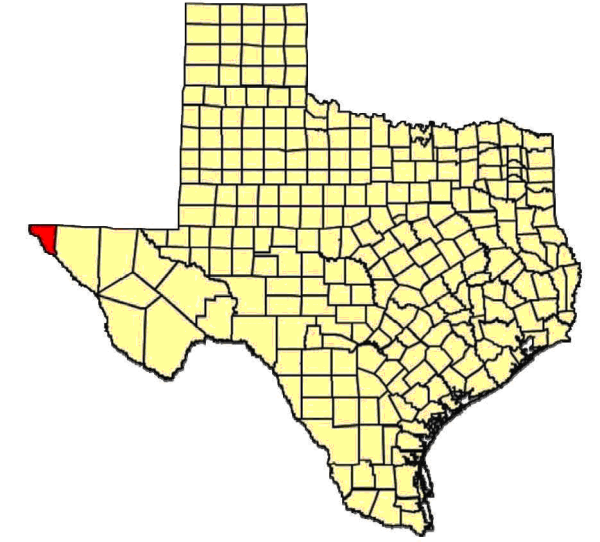
Work Session Agenda Item No. 13
Exhibit B
Vicinity Map
Franklin Mountains State Park
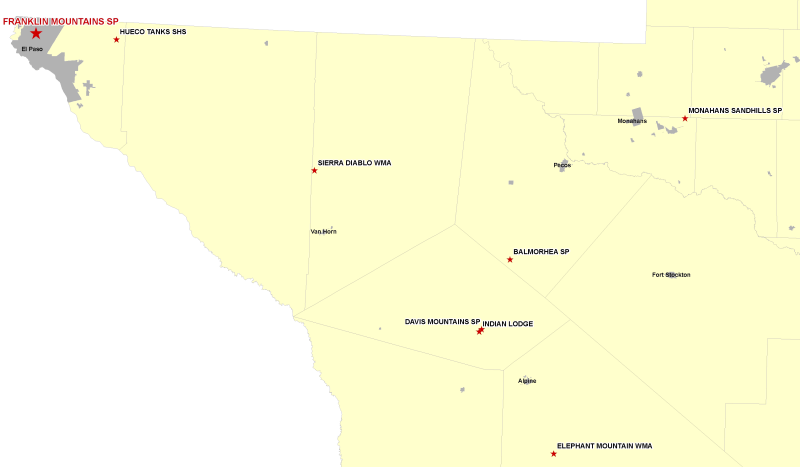
Work Session Agenda Item No. 13
Exhibit C
Site Map
Franklin Mountains SP
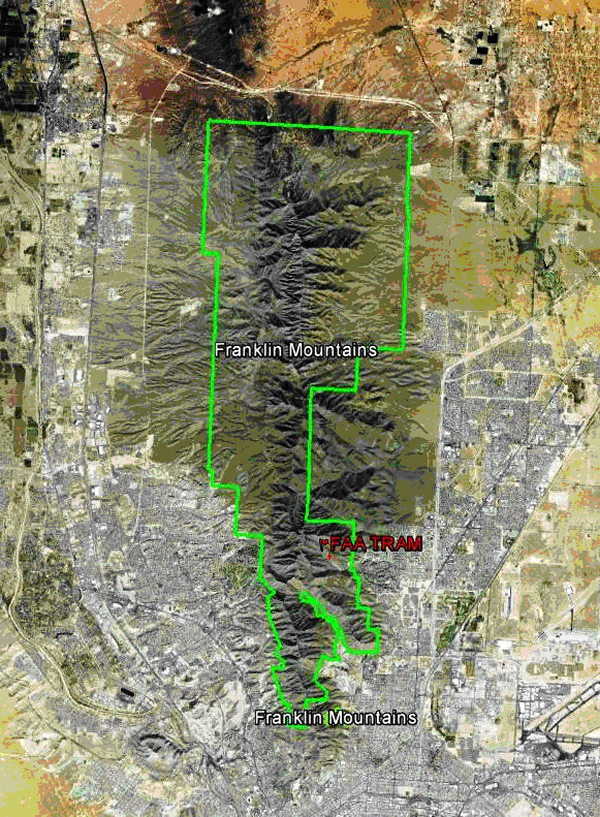
Work Session Agenda Item No. 14
Presenter: Ted Hollingsworth
Work Session
Request for Pipeline Easement – Parker County
Pipeline Crossing Lake Mineral Wells Trailway
November 7, 2012
I. Executive Summary: Texas Express Gathering LLC requests an easement to directionally drill an 8” gathering line across the right-of-way for the Lake Mineral Wells Trailway.
II. Discussion: The Lake Minerals Wells State Trailway is a former right of way for the Missouri Pacific Railroad, acquired by TPWD in 1996, for the purpose of creating a 20-mile hike/bike/equestrian corridor connecting Weatherford in Palo Pinto County and Mineral Wells in Parker County. Due to the linear nature of the trailway, there are a number of roads, utility corridors and pipelines that cross it. In recent years, TPWD staff has attempted to minimize impacts to the trailway, especially visual impacts, by requiring infrastructure to be bored under the trailway corridor, with no surface occupancy or surface expression on TPWD land.
Texas Express Gathering LLC requests an easement to install by directional drilling, an 8” diameter gathering line to serve local oil and gas production operations five miles northwest of downtown Weatherford, 2.8 miles from the Weatherford terminus of the trailway. The line is to be bored entirely beneath the trailway, with all entry/exit points located off-site. Standard damage and easement compensation is to be paid per the current TPWD rate schedule. Staff requests permission to begin the public notice and input process.
Work Session Agenda Item No. 14
Exhibit A
Location Map for Lake Mineral Wells Trailway in Parker County
Weatherford to Mineral Wells
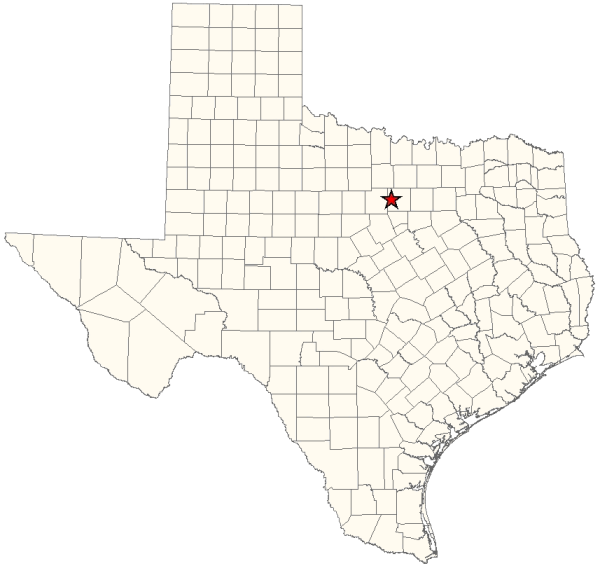
Work Session Agenda Item No. 14
Exhibit B
Vicinity Map for Lake Mineral Wells Trailway
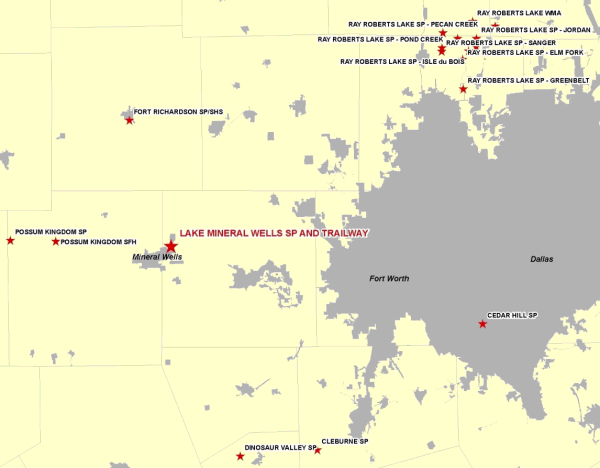
Work Session Agenda Item No. 14
Exhibit C
Project Location Map
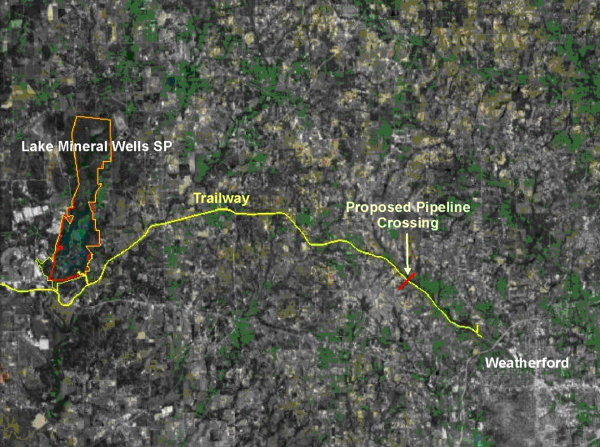
Work Session Agenda Item No. 14
Exhibit D
Site Map
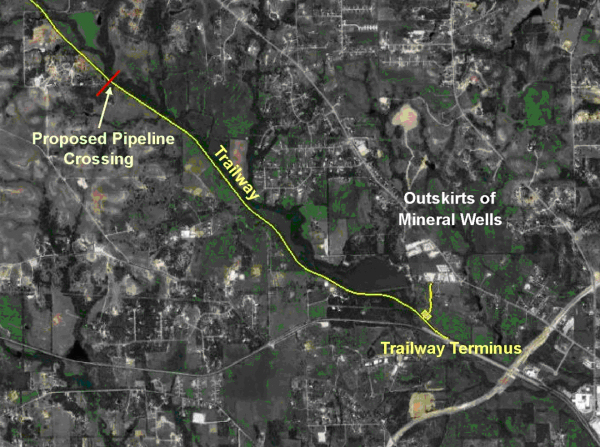
Work Session Agenda Item No. 16
Presenter: Ted Hollingsworth
Work Session
Acceptance of Land Donation – Brazoria County
Approximately 480 Acres at the Christmas Bay Coastal Preserve
November 7, 2012
I. Executive Summary: Brazoria County has been awarded a Coastal Impact Assistance Program (CIAP) grant for the acquisition of a tract of land adjacent to the Christmas Bay Coastal Preserve for conveyance to Texas Parks and Wildlife Department (TPWD).
II. Discussion: The Christmas Bay Coastal Preserve covers a shallow bay on the west end of the Galveston Bay estuary system. Christmas Bay is bounded on the north and west by the Brazoria National Wildlife Refuge and on the south by Follets Island, severed from the mainland decades ago by excavation of the Gulf Intracoastal Waterway. The subject tract straddles Follets Island from the south shore of Christmas Bay to the Gulf of Mexico and is owned by the Texas General Land Office (GLO). At one time the tract was owned by TPWD and was known as Christmas Bay State Park, but was conveyed to the GLO in an exchange mandated by the 75th Texas Legislature in 1997. The tract remains undeveloped and continues to have high conservation values both for the marshes and prairie habitat of the tract itself and for protecting Christmas Bay from further development.
TPWD worked with Brazoria County to apply for a CIAP grant for the acquisition of the property in the 2009 grant cycle. The funds were awarded, and are now available to complete acquisition by the county and transfer from the county to TPWD. GLO is a willing seller at appraised value. The tract would be managed by the Coastal Fisheries Division as part of the Coastal Preserve for its outstanding fish and wildlife values.
Staff requests permission to begin the public notice and input process associated with the transfer of this tract from Brazoria County to TPWD.
Work Session Agenda Item No. 16
Exhibit A
Location of Christmas Bay Coastal Preserve in Brazoria County
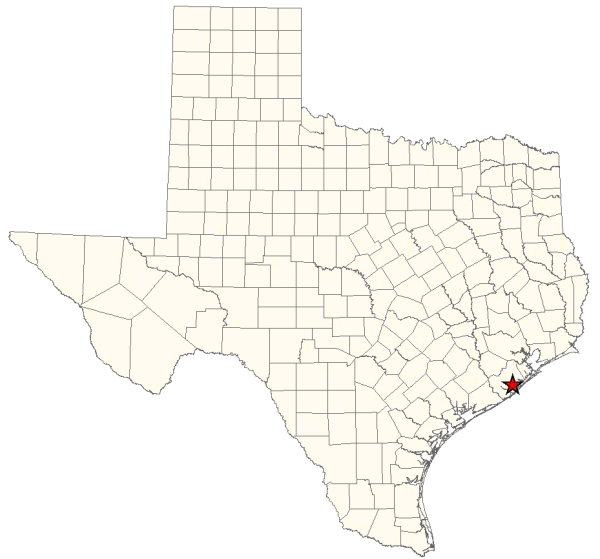
Work Session Agenda Item No. 16
Exhibit B
Vicinity Map for Christmas Bay 20 Miles Southwest of Galveston
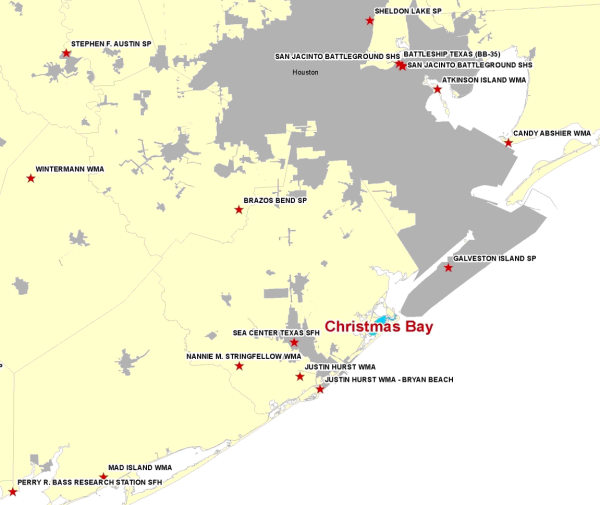
Work Session Agenda Item No. 16
Exhibit C
Map of Christmas Bay Showing Brazoria National Wildlife Refuge and the Subject Tract
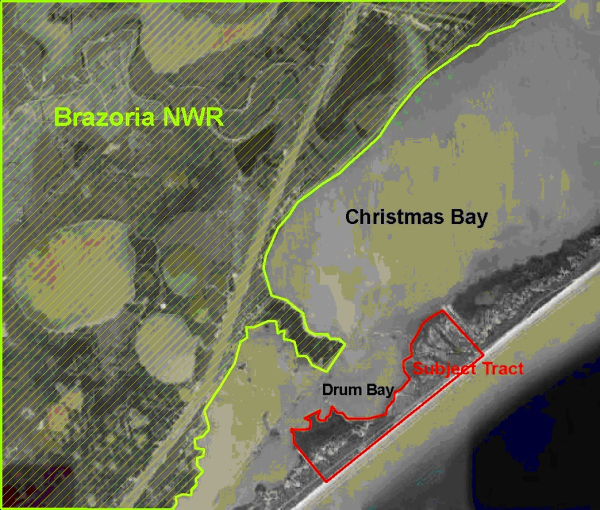
Work Session Agenda Item No. 16
Exhibit D
Site Map for the Subject 480 Acres on Follets Island
Subject Tract Outlined in Black
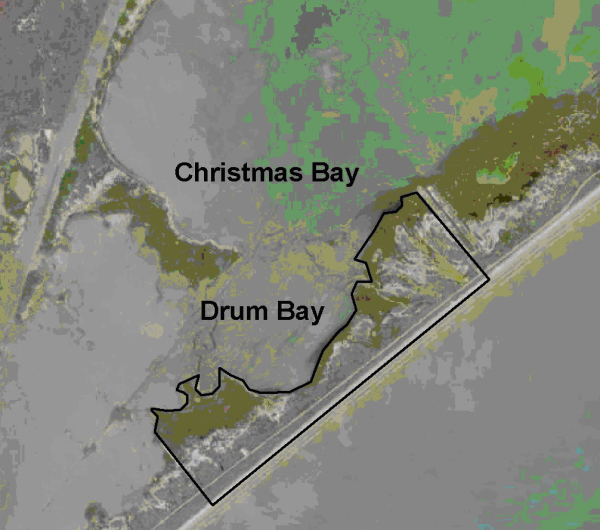
Work Session Agenda Item No. 18
Presenter: Corky Kuhlmann
Work Session
Land Acquisition – Nacogdoches County
Alazan Bayou Wildlife Management Area
November 7, 2012
I. Executive Summary: Texas Parks and Wildlife Department (TPWD) has been offered the donation of approximately 60 acres of land as an addition to the Alazan Bayou Wildlife Management Area (WMA).
II. Discussion: The donation property is 50 percent scrub-shrub swamp and 50 percent bottomland hardwoods adjacent to Alazan Bayou WMA. It is an important adjacent property with significant wetland values. The tract provides foraging habitat for Mallards, Wood Ducks and other dabbling ducks, and is utilized as brood habitat for Wood Ducks. Habitat is identical to the WMA side with important moist soil plants in the swamp and bottomland oaks on the more upland areas that provide food sources for waterfowl and other species. It will provide additional public hunting opportunity to TPWD constituents. Acquisition of the property would preserve the bottomland habitat from fragmentation and or agricultural use.
Staff would like to begin the process of providing public notice and obtaining public input regarding acceptance of the proposed donation of an approximate 60 acre tract as an addition to the Alazan Bayou WMA.
Attachments — 3Work Session Agenda Item No. 18
Exhibit A
Location of Alazan Bayou WMA, Nacogdoches County
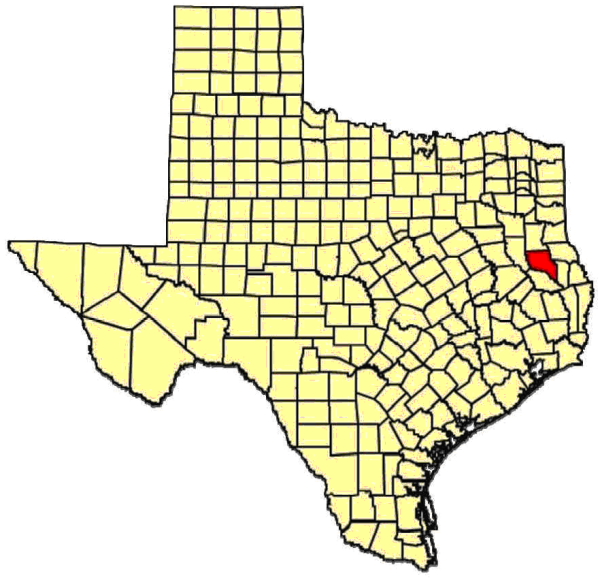
Work Session Agenda Item No. 18
Exhibit B
Vicinity Map
Alazan Bayou WMA
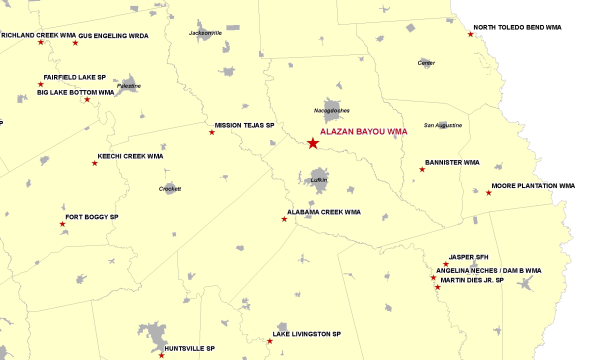
Work Session Agenda Item No. 18
Exhibit C
Site Map
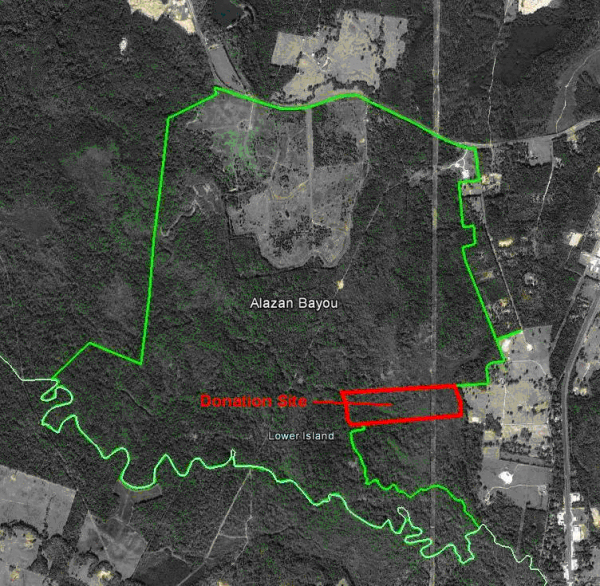
Work Session Agenda Item No. 19
Presenter: Corky Kuhlmann
Work Session
Land Acquisition – Hemphill County
Gene Howe Wildlife Management Area
November 7, 2012
I. Executive Summary: Texas Parks and Wildlife Department (TPWD) is in negotiations for the acquisition of up to 473 acres of land as an addition to the Gene Howe Wildlife Management Area (WMA).
II. Discussion: TPWD staff is currently in negotiations with the General Land Office for the acquisition of up to 473 acres of school fund land as an addition to the Gene Howe WMA. The tract would offer additional recreation opportunities and preserve the land from potential fragmentation and or agricultural use.
Staff would like to begin the process of providing public notice and obtaining public input regarding a proposed acquisition of an approximate 473 acre tract as an addition to the Gene Howe WMA.
Attachments — 3
Work Session Agenda Item No. 19
Exhibit A
Location of Gene Howe WMA, Hemphill County
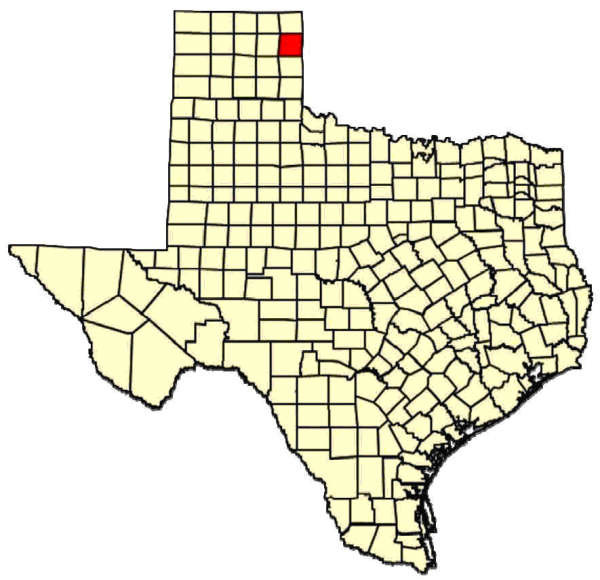
Work Session Agenda Item No. 19
Exhibit B
Vicinity Map of Gene Howe WMA
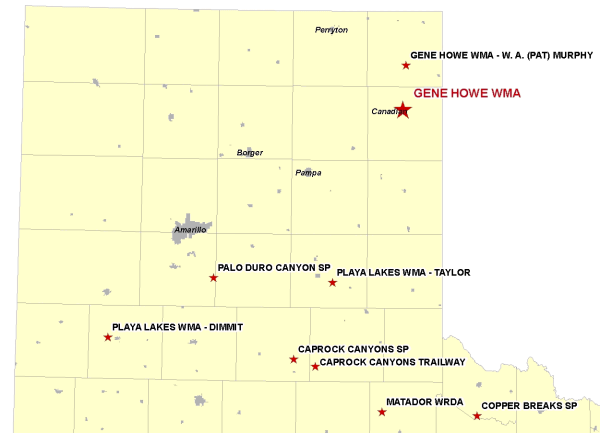
Work Session Agenda Item No. 19
Exhibit C
Site Map Show Location of 473-acre Subject Tract
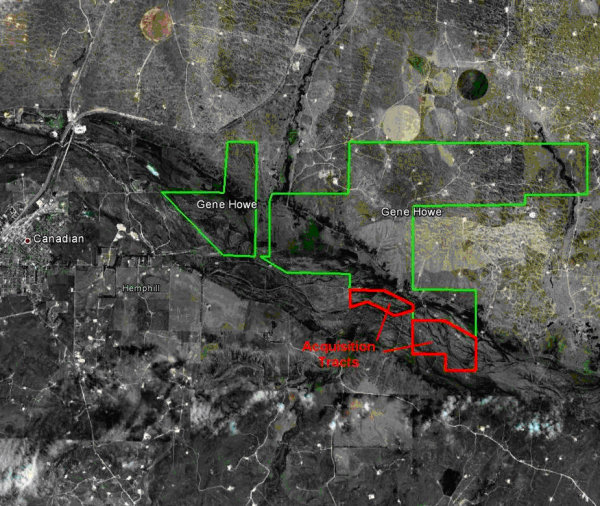
Work Session Agenda Item No. 20
Presenter: Corky Kuhlmann
Work Session
Land Donation – El Paso County
November 7, 2012
This item has been withdrawn.
Work Session Agenda Item No. 21
Presenter: Corky Kuhlmann
Work Session
Land Sale and Trade – Bastrop County
November 7, 2012
I. Executive Summary: Texas Parks and Wildlife Department (TPWD) staff is seeking to resolve boundary line discrepancies along Park Road 1C between Bastrop and Buescher State Parks.
II. Discussion: As a result of the Bastrop area fires, TPWD staff surveyors have been requested to survey the right-of-way of Park Road 1C, a scenic corridor between Bastrop and Buescher State Parks, for the purpose of establishing boundary lines and rebuilding fence. During the course of this surveying there were fence and boundary line discrepancies discovered that will need to be resolved, of which two will be discussed.
1. Land trade in which TPWD will be deeded approximately 3.5 acres in exchange for approximately 1 acre of park land.
2. Land sale of approximately 0.75 acre of park land.
Staff would like to begin the process of providing public notice and obtaining public input regarding sale, donation, trade or acquisition of any and all areas of fencing discrepancies along Park Road 1C and bring individual transactions to the Commission as Action items in future meetings.
Attachments — 3
Work Session Agenda Item No. 21
Exhibit A
Location Map
Bastrop County
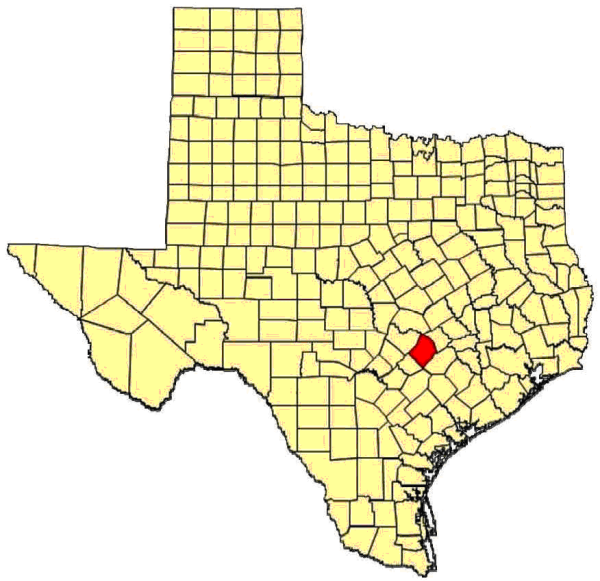
Work Session Agenda Item No. 21
Exhibit B
Vicinity Map
Bastrop, Buescher State Park
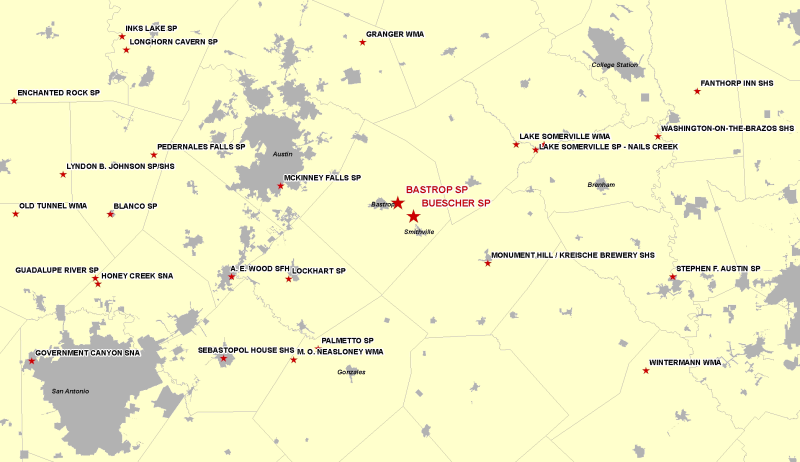
Work Session Agenda Item No. 21
Exhibit C
Site Map
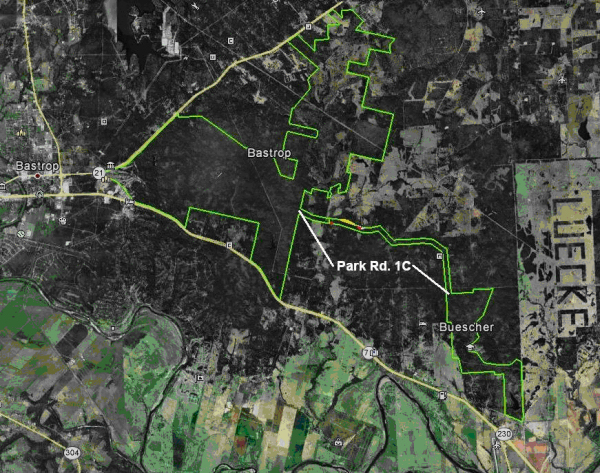
Work Session Agenda Item No. 22
Presenter: Ted Hollingsworth
Work Session
Request for Deed Modification – Harris and Montgomery Counties
Authorization of Pipeline Easement at Lake Houston Wilderness Park
November 7, 2012
I. Executive Summary: The City of Houston requests modification of the deed to Lake Houston Wilderness Park, formerly Lake Houston State Park, to allow installation of a 24” product pipeline.
II. Discussion: In 2006, Texas Parks and Wildlife Department (TPWD) transferred to the City of Houston, the 4,920 acre tract then known as Lake Houston State Park, for development and operation by the City of Houston Parks Department. The deed contained restrictions prohibiting any industrial use of the property. Enterprise Crude Pipeline Company LLC (Enterprise), requests an easement from the City of Houston to install a 24” diameter liquid hydrocarbons pipeline across this property. A modification of the deed from TPWD to the City of Houston is necessary prior to the issuance of the requested easement. The City requests that TPWD grant the required deed modification.
TPWD staff has worked with the City and with Enterprise to determine that there is no reasonable and prudent alternative to the proposed pipeline route, and to minimize impacts to natural and cultural resources. Staff requests permission to begin the public notice and input process regarding the requested deed modification.
Attachments — 3
Work Session Agenda Item No. 22
Exhibit A
Location Map for Lake Houston Wilderness Park
in Harris and Montgomery Counties
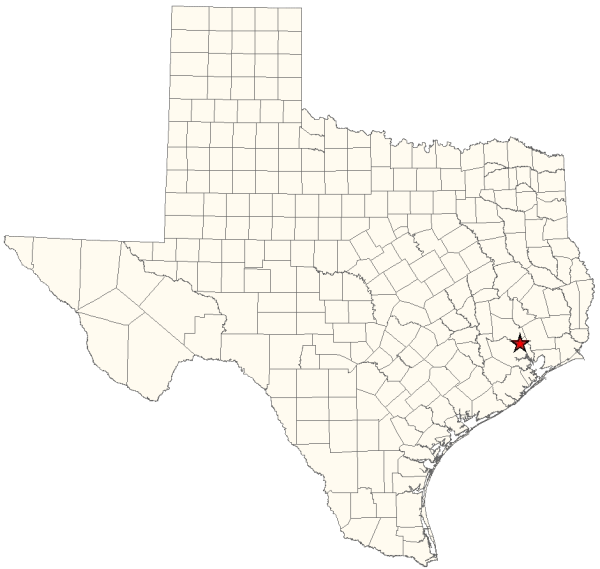
Work Session Agenda Item No. 22
Exhibit B
Vicinity Map for Lake Houston Wilderness Park 25 Miles North of Houston
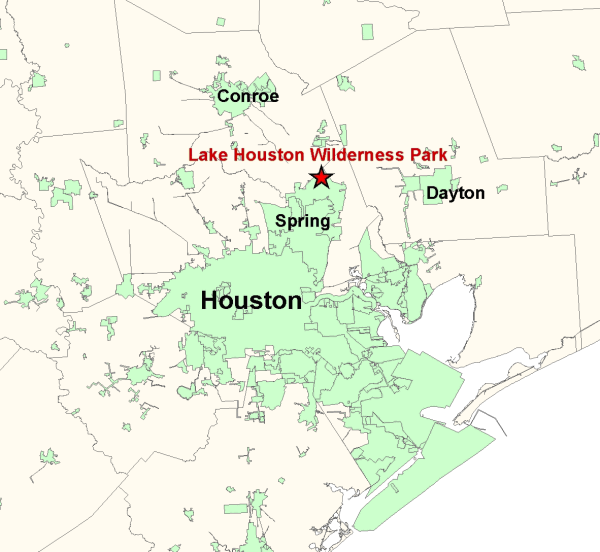
Work Session Agenda Item No. 22
Exhibit C
Site Map Showing Proposed Pipeline Route
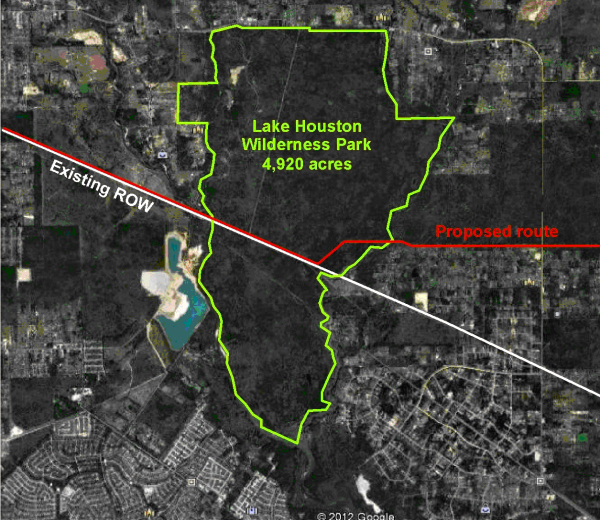
Work Session Agenda Item No. 23
Presenter: Ross Melinchuk
Work Session
Update on Surface Use Negotiations – Dimmit and La Salle Counties
Oil and Gas Development at the Chaparral Wildlife Management Area
November 7, 2012
I. Executive Summary: Staff will brief the TPW Commission on the status of negotiations to protect the surface of the Chaparral Wildlife Management Area during proposed oil and gas exploration and recovery activities.
II. Discussion: The 15,200-acre Chaparral Wildlife Management Area (WMA) sits above the Eagle Ford shale geological formation, which is proving to be one of the richest oil and gas producing formations in North America. “Three-D” seismic surveys, horizontal drilling techniques and hydraulic fracturing, or “fracking” have made the exploitation of the Eagle Ford shale technically and economically productive, and extensive efforts are underway to tap the oil and gas resources of this formation throughout its range in south Texas.
The current holders of exploration and recovery rights under the WMA include Talisman Energy Inc., and Anadarko Petroleum Corporation. Oil and gas exploration and recovery operations are expected to permanently alter the WMA. Habitat for four state listed species, fish and wildlife values, thirty-plus years of intensive conservation research, public hunting and a variety of other recreational uses will be adversely affected.
TPWD staff continues to work with Talisman and Anadarko to draft Surface Use Agreements for exploration and recovery operations consistent with the TPWD’s mission to minimize adverse impacts to biological and recreational values.
Attachments — 3
Work Session Agenda Item No. 23
Exhibit A
Location of Chaparral WMA in LaSalle and Dimmit Counties
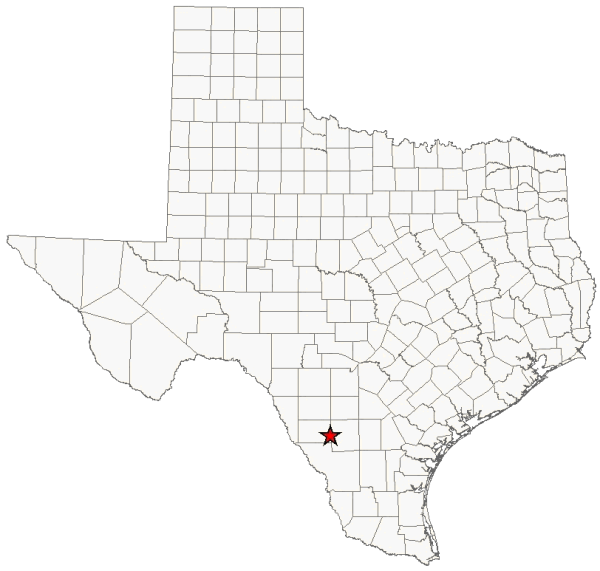
Work Session Agenda Item No. 23
Exhibit B
Vicinity Map for Chaparral WMA 55 miles north of Laredo
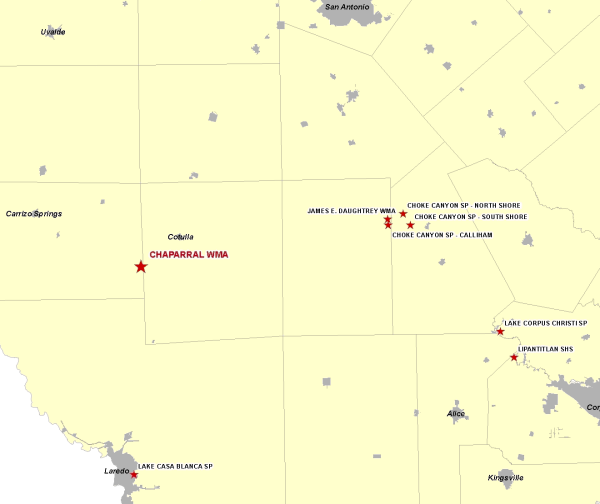
Work Session Agenda Item No. 23
Exhibit C
Site Map for the 15,200-Acre Chaparral WMA
